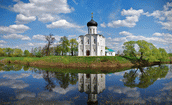| |
Russian Revolution's Forum
E-books World history, Rus' history and Religions history
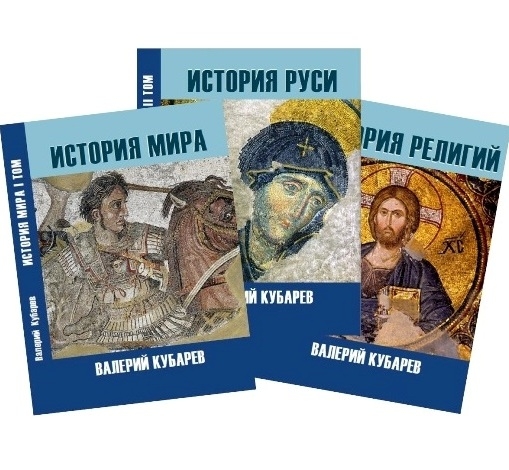
Modernization of Russia
Holy Russia - Third Rome
The new subject of international law, the State Holy Russia - Third Rome, 21.09.2013. | Nova Church of Holy Russia
Orthodoxy and Christianity require reforming and release of heresy and obscurantism. 21.09.2011. | Ethnopolitical transformation of Russia New!!!
The author investigates the deep ethnic and political processes occurring within Russian society. Russian statehood and the people are at a historical crossroads. The path chosen by the authorities leads to a dead end of a renewed Kyrgyz Khaganate. The alternative will allow the Russian people to achieve a European renaissance and rid themselves of barbarism and savagery. 08/26-09/06/2025. | The Seljuk Dynasty Origin New!!!
The author put forward a hypothesis according to which the Seljuk’s Sultans came from the Princes of the Russ – Rurikovich Kin, who eventually converted to Islam. The hypothesis was fully confirmed by the identification of the main historical figures of the Seljuk dynasty with the descendants of the Princes St. Vladimir and Yaroslav the Wise. We are talking about the rulers of Sultanate of Rum Sultan Suleiman and his descendants, as well as Tuqaq, Seljuk, Mikail, Israel, Toghrul, Alp Arslan and other Sultans. Princes and their sons from the Principality of Tmutarakan became Seljuk’s Sultans, from where they conquered the countries and peoples of the Caucasus, Iran, Asia Minor and Central Asia. 24.05–12.06.2023. | Synchronization of historical and religious Chronicles
The author correctly synchronizes historical and religious Chronicles of the Ancient World based on a short chronology and linking events to unique celestial phenomena reflected in the annals and Scriptures. The author believes that discrepancies in dates, geographical localities and ethnic origin of historical and religious figures are due to erroneous traditional chronology and historical geography, as well as the deliberate adaptation of phenomena and events to an established paradigm. 20.04–25.05.2020. | Astronomical dating of Biblical events
The author's reconstruction of the history and chronology of religions is fully verified by identifying 15 celestial phenomena described in the Chronicles, including 11 Solar Eclipses, 3 Zodiacs and 1 Supernova. A chronological shift of 1780 years in the history of Ancient Egypt has been confirmed for 6 phenomena, including 3 Solar Eclipses and 3 Zodiacs, including the Eclipse of Pharaoh Takelot on August 8, 891. Astronomically confirmed the date of the Crucifixion of Jesus Christ as March 18, 1010, and the date of death of Ibrahim – the son of the Prophet Muhammad as February 7, 1152 (28 Shawwal 546 AH). 20.02–31.03.2020. | Origin of the gens Rurik
After the break of ties between the metropolis and the Russian principalities, the annals of Byzantium were cleared of the mention of "foreigners" in the management of the Empire, and the Chronicles of Russia did not have time to properly reflect the role of Rurik in world history. A study of the sources of Ancient Rome, New Rome, Russia, Arab countries, Danube and Volga Bulgaria allowed the author to identify the Russ gens and Bulgarian Khagans with the Flavian dynasty, as well as to identify Rurik, his descendants and relatives from the Macedonian dynasty (IX–XI century) and dynasty of Lecapenus (X century). The last Russian Emperor of New Rome been Yaroslav the Wise, throne name Constantine Monomachos. 11.09–21.10.2019. | Chronology of monotheistic religions
The author identified the Patriarchs of monotheism with well-known figures of human history. He proved that the oldest religion of monotheism is Christianity, which had a theoretical character in the I Millennium (Old Testament Christianity) and a practical embodiment at the beginning of the II Millennium (New Testament Christianity). Islam and Judaism emerged only in the early VII century and became radical branches of Christianity. Based on the study of solar eclipses, the author has determined the date and place of the Crucifixion of Jesus Christ (March 18, 1010 in Constantinople), the year of the death of the Prophet Muhammad (1152) and the period creation of the Quran (1130–1152). 01–27.08.2019. | Localization of Ancient Rome
The history of Ancient Rome is well studied, but hides a lot of inconsistencies and contradictions relating to the period of formation of the city and the expansion of the Romans into the world. We believe that the problems are caused by ignorance of the true localization of Ancient Rome in the Volga region on Akhtuba until the Fire on 64 and move city to location of Veii in Italy. The article also considers the aspects of ethnic origin of the peoples of the Latin League, Ancient Rome and Europe. The vector of expansion of Ancient Rome from the Volga region to the Europe coinciding with the migration flows of the Migration Period and the spread of PIE is substantiated. In addition the article considers the dynamics of growth and decline of the population of Ancient Rome in the localities from its inception to sunset and transformation. 23.06–16.07.2019. | Short chronology of Ancient Egypt
The history of Ancient Egypt generated in XIX century, every day finds out all greater discrepancy to modern realities both the newest archeological and tool data, including results of DNA researches of mummies of the Egyptian pharaohs. The chronology of Egypt as whole is considered well investigated and however it has been created for substantiation of an antiquity of Jewish people, instead of for scientific description of one of most ancient terrestrial civilizations. Author's reconstruction of chronology of Ancient Egypt has found out time shift at rate 1780 years in depth of centuries from true dating events. 1-16.06.2019. | Great Tartary or Slavic Empire
The next riddle of world historiography is solved. Present clause is devoted to history and modern condition of one of the most grandiose empires of terrestrial civilization – Great Tartary or Slavic Empires. 04–19.09.2017. | The European Aryans
In present clause the broad audience of the questions connected to probable Aryan origin of various European peoples is considered. Including aspects of possible an Aryan origin of Slavs and prospects of presence by these of special way to world around are considered. 25.02.2017 - 24.03.2017. | Summarizing of Zemsky Sobor 2016 (Land Assembly 2016)
Within the framework of carrying out Zemsky Sobor 2016 (Land Assembly 2016) on elections of Grand Prince of All Russia four Nominees have been put forward. The overwhelming majority of voices have been given for Nominee Grand Prince Valeriy Viktorovich Kubarev. Will of God and decision of participants of Assembly, Zemsky Sobor 2016 has elected lifelong Grand Prince of All Russia Valeriy Viktorovich Kubarev Grand Kubensky Rurikovich. 11.05.2016. | Yaroslavl’s Princes Rurikovich
In clause is described family tree of Grand Princes of Yaroslavl and their descendants, it is the senior branch of the Kin of Russ – Rurikovich, going back to Mstislav Great Monomachos. Kin of the Grand Princes of Yaroslavl have continued by Princes Grand Kubensky – Kubarev. 22.02.2016–11.03.2016. | All truth about Saint Prince Vladimir
In clause the all truth about Saint Prince Vladimir which is ignored Orthodox and Romanov’s historians, communistic historical science and their modern adepts, fabricating myths about Russ with « good intentions » opens without denominations. The kin of Russ - Rurikovich has created Orthodoxy and the Russian statehood, Russian people began to forget about it. Glory to Russ! 07-17.07.2015. | Brief chronology of religions
The report at XXX International conference on problems of the Civilization, 25.04.2015, Moscow, RosNoU. In the clause the final Chronological Tables of Ancient Egypt, Ancient and New Rome, Rome in Italy, Christianity, Islam and Judaism are submitted. 25.04.2015. | Canons of Orthodoxy of XIV century and the present time
The report at XXIX International conference on problems of the Civilization, 20.12.2014, Moscow, RosNoU. In the report the comparative analysis of canons of Orthodoxy of XIV century (1315-1321), displayed on mosaics and frescos of Church of Chorus in Istanbul, and modern doctrines are made. Numerous differences of events of the Holy Legend and the Gospel of the past and the present are found out. 20.12.2014. | Ethnic threats to peoples of Russia
In clause political, economic, cultural and religious aspects of consequences of ethnic opposition of radical peoples of Russia and new coming Slavic population formed as result of violent Slavic expansion in Russia in days of the Mongolian yoke are considered. The historical reasons of occurrence of ethnic contradictions are investigated, estimations of modern condition of problem (Chechelevskaya and Lubotinskaya Republics in 1905, Donetsk national republic and Lugansk national republic in 2014 in territory of Ukraine) are given and offers on decrease in escalation of ethnic opposition in territory of Eurasia are made. 09.06 - 05.07.2014. | Attribution of Rurikovich and Emperors Lecapenus
The report at XXVIII International Conference on problems of the Civilization is 26.04.2014, Moscow, RosNoU. In clause it is described detailed attribution of Ugrian Tsars with Emperors of Ancient and New Rome and Patriarches of terrestrial civilization. It is scientifically proved origins of all patriarches of monotheism and Emperors Flavius and Lecapenus from kint of Ugrian Tsars of Russ (Great), is the ethnic Finn-Ugrian from Volga region. 23.03.2014 – 24.04.2014. | Putin's Eurasian impasse
Vladimir Putin and Uniform Russia realize the Eurasian project, involving Russia and Russian people during stagnation and backlogs from World Civilization. They create Gog and Magog Empire, menacing to world peace. Why the Kremlin authority has not asked Russian Slavs – they want to live in the Asian country or to be safe Europeans? 14-22.01.2014. | Projections of the God in symbols of religion
As result of studying the extensive visual material created by 3D modeling, we have proved existence of uniform source of an origin of Projections of the God, that is religious symbolic of people. The source or quantum object refers to the Chariot of the God. We believe that on the basis of our researches, it will be possible to organize training to travel on the Universe of space navigators from the most gifted people and to create spaceships with engines as the described quantum generator is Chariots of the God or the Chariot of Cube. 25–30.08.2013. | Origin and migration of Slavs
Historical and genetic routes of migrations of the Slavs, calculated with the help from ancient Byzantium, European, Chinese, Arabian, Bulgarian and Russian chronicles and annals, and also modern researches of man's DNA chromosomes. 01-21.05.2013. | Empires of cousins of Russ
The report at scientific XXVI International conference on problems of the Civilization 26-27.04.2013, Moscow, RosNoU. In article five world Empires of cousins of Russ (Great) existing in our era on open spaces of Eurasia with cyclicity of occurrence once in 300 years are described. | Hungarian Kingdom of Russ
It is continuation of research of dynastic communications of Rurikovich. Cousin of Rurik Almysh/Almos and his children Kazan/Kurszan and Arbat/Arpad, it is all ethnic Ugrian of Russ, have based at the end of IX century – beginning of X century the Hungarian kingdom of Russ, having grasped Great Moravia. 08-11.01.2013. | Reconstruction of dynastic communications of Rurikovich in IX-XI centuries
Report at anniversary scientific XXV International conference on problems of civilization at 21-22.12.2012, RosNoU, Moscow. Corrected at 03.01.2013. | Educated Christianity of Russ
Bible – the Old Testament and the New Testament has exhausted itself. Forged the Scripts and the Sacred Legend cannot serve more as a spiritual reference point for promotion of mankind forward on the river of time. It is allowable to use only spiritual – moral potential of the ancient products being product of national creativity of Jews and Catholics, instead of divine revelations. The chronology of Bible events, an ethnic accessory of patriarchs of mankind, names, geography and original languages of heroes of the Bible do not correspond to the validity. Bible miracles have the quantum nature in the basis and submit to laws of a universe. Educated Christianity of Russ restore the religious both destroyed obscurantists religious and scientific knowledge of Christianity and revolutionary role of religion in history of civilization. 26.08. – 12.10.2012. | True Empty Tomb
Nova Church of Sacred Russia and Sacred Russ, Princes of Russia congratulates mankind on presence of True Empty Tomb and restoration of the religious and historical truth. The true has triumphed forever. 20-29.05.2012. | Orthodoxy and Islam in Old Russia
The report at XXIV International scientific conference on problems of the Civilization in Russian New University on April 20-21, 2012. | Day of Church Slavonic writing. Russ Cyril and Methodius.
In this significant holiday of Day of Church Slavonic writing and remembering Equal Apostles Sacred Cyril and Methodius, Princes of Russ convincingly ask Russian Orthodox Church and the public of the orthodox countries to return to sources and correctly to name the writing, language and church books Russian, but not Slavic. Ancient Russia was the Finno-Ugric state created by Russ Christians Rurik and Igor, Cyril and Methodius, Askold and Dir, Prophetic Oleg and Sacred Olga, Sacred Vladimir and Empress Anna Macedonian.
24.05.2011. | Wars of Russ in IX-XI centuries
In article on a rich actual material it is shown, that all wars of Russ with Byzantium in 836-1043 have been connected to deduction of a throne of empire by Russian party of Constantinople headed by the Macedonian dynasty of Russ. To the author it is proved, that two centuries co-emperors of New Rome were Great Princes Rurikovich. Last Russian emperor Jaroslav Mudry known in Tsar Grad as Constantine Monomakh was. The report at scientific XXII International conference on problems of the Civilization 22-23.04.2011, Moscow, RosNoU. | Genetic distances between cousins Rurikovich
The report at scientific XXII International Conference on problems of the Civilization, on April 22-23, 2011, RosNoU, Moscow, Russia. 24.04.2011. | Slavic-Mongolian invasion to Russia
Results of our research of an origin of Slavs have not simply scientific, but political value. In view of the received data it is necessary to form the weighed policy of interethnic and inter religious attitudes in Russia and the world. The modern hobby of Russian Slavs Rodoverie, the Aries origin and the contemptuous attitude to inhabitants of Central Asia, Caucasus, Mongolia, China and other regions of the world bears a system and logic mistake. Rodoverie in general it is senseless, in fact ancestors Rodoverian in Russia and Ukraine have left Central Asia and were Kirghiz, Altaian’s, Tajik’s, Pashtun’s, Uyghur’s and Juan-Juan, and completely not blond demigods. 12-18.03.2011. | Old Rome and Italic union of the Volga region
The scientific article on an extensive historical material proves that Ancient Rome has been created by Finno-Ugric tribe’s of Italic union of the Volga region (Idel, Bulgar). Italic peoples Vestini (Vesi), Marsi (Merya), Lucani (Lucane), Marrucini (Marri) and others till now live on Volga. Finno-Ugric named Latinas (Latinyanami) German peoples of the Volga region, differently Altyn-ami that means Gold literally. Fortress Alba Longo was called Altynbash, and Volga region Rome – Ulak-Urum. Southwest capital of Finno-Ugric of Idel was city Phanagoria or the Finn–Ugoria, being in antiquities capital Bosporus Empire and Great Bulgaria was. The web of lies of the western falsifiers of history how many would not be twisted, but to it all the same there comes the end. 10-21.02.2011. | Correct genographic
We have proved fidelity Bulgarian theory of an origin of mankind. She proves to be true a natural vector of moving of people on a planet from the Volga region in all parties of Eurasia, and there from to Africa, Australia and America. All peoples and races of the world have taken place from Hindi-European, namely – from ethnic Finno-Ugric. 01-07.02.2011. | Correct DNA-Genealogy and glottochronology
Scientific article of Grand Prince Valeriy Kubarev on DNA-Genealogy and glottochronology is submitted to your attention. The author has created formulas with which help it is possible to define precisely time of life of the general ancestor and an epoch of formation of various languages. These formulas have received the name of Kubarev’s formula. With the help of mathematical calculations, Valeriy Kubarev has proved fidelity Barrow of Hypothesis of Maria Gimbutas and own reconstruction of a history of the world. We hope that results of research will find wide application in DNA-Genealogy and glottochronology. 04-14.01.2011. | Genealogy and genetics of Princes of Russia
The report of Grand Prince Valeriy Kubarev at XXI International Conference on problems of the Civilization 25.12.2010. Valeriy Kubarev's scientific article describes genetics of Rurikovich and Sorts of Russia. Grand Prince has scientifically defined modal haplotype of Rurik, Gedimin, Russ Aydar, Kubrat, Flavius and has theoretically described modal haplotype of Alexander Great, Jesus Christ Zlatoust, Prophet Mohammed and Genghis Khan. All these well-known people ethnically Finno-Ugrian from the Sort of Russ. 25.12.2010. | What do we celebrate on November 4? Loss of the national sovereignty...
National voting or voting of national representatives is unacceptable for elections of Tsar and Grand Duke, in fact tsar from the God, and the voice of people is not a voice Divine. Elections of Grand Duke only voting of Princes – patrimonial aristocracy of Russia are possible. 08-21.11.2010. | Turn of the Earth promptly comes nearer
This is article with the analysis of abnormal geophysical and climatic activity on a planet. 09-12.09.2010. | Baltavar – a symbol of Christianity, an Islam and Judaism
Petrarca: « When people will address to the history, his greatness come to live »
30-31.03.2010 | History of Russ about 3506 BC till 2012
Kubarev V.V.'s report, History of Russ about 3506 BC till 2012.
Section «Civilization aspects of the Russian history and chronology».
Tenth International scientific conference «Civilization of knowledge: global crisis and an innovative choice of Russia», Moscow, April 24-25, 2009, RosNOU. | Archive 2006-2018 |
Whose fault is it?
The Catechon Paradigm as an instrument of the Antichrist New!!!
In the article, the author examines the current state of the catechon paradigm and the practice of using the provisions of the concept in the political and public life of the Russian Federation. According to the author, the idea of the catechon in Russia was intercepted by the forces of evil and used as a screen to cover their deeds. Today, the catechon paradigm has become an instrument of the Antichrist and his adherents to gain world domination. The only resource for Lucifer’s conquest of the world is sinful people whom he can attract under his banners. As successful as his deception and seduction will be, so strong and numerous will be the army of Satan. 05–17.12.2022. | Impairment of Orthodoxy New!!!
In the article, the author has carried out a retrospective analysis of the events and processes that led to the impairment and transformation of the canons of Orthodoxy and the patristic tradition of Russian Christianity. Prohibitions and reliance on the good intentions of opportunists within the body of the church led to a natural distortion of the teaching. As a result, the Orthodox Church became vulnerable to the pressure of Lucifer's lies and deception and ceased to be a source of life. 30.09–25.11.2022. | Features of Christianity in Cappadocia New!!!
The usual facts for Cappadocia were the proximity of male and female Monasteries and their communication. The plots and frescoes of the Churches were created no earlier than the first quarter of the XI century. The isomorphic images of St. George, Theodore Stratelates and Theodore Tiron have come down to us. According to the author, St. George became a collective image of the Saints Constantine the Great and the two Theodores. The fresco of the Serpent Church depicts Onuphrius the Great as a hermaphrodite, which the Church is trying to forget. On the face of the purposeful distortion by Christianity of the Holy Tradition, led by the Holy Spirit, and the removal from the original sources. 05–28.08.2022. | Emperors Lekapenos(920–945)
Based on a thorough analysis of the chronicles of New Rome, Ancient Russia, Great Bulgaria and Arab sources, the author has justified the Finno–Ugric origin of the Macedonian Dynasty and the Lekapenos Dynasty. The details of the biographies, names, dates of rule and family ties of dozens of Emperors, Khagans and Princes of Byzantium, Russ and Bulgar coincide with great accuracy, which makes it possible to identify all the studied personalities with real historical figures. In local chronicles, they have different or identical names, depending on the national characteristics of the nicknames of the studied persons. 07.12.2020–30.01.2021. | Dancing on bones (people losses of USSR in SWW)
We have found out the facts of direct falsification of human losses of military men and civil persons of the USSR within the Second World War in some millions person. Forgery is caused by activity of the propaganda machine of the USSR and false understanding of patriotism in modern Russia. By our calculations true irrevocable losses of the population of the USSR within the SWW make 7.6–8.7 million persons from among military men and the general losses with civil people 12.8–13.9 million persons. Have run away from Stalin paradise of USSR is hundred thousand (up to 1.3 million) the persons. We believe that the name of each victim of war should be taken into account and sounded publicly. 04–18.05.2019. | Expansion of Rome from Volga region
The report at XXXIII International conference on problems of the Civilization, 24.12.2016, Moscow, RosNoU. In the report the extensive information on resettlement of peoples to Europe through ports of Bosporan Kingdom and Bosporus to the Mediterranean from the Volga region, Siberia and Caucasus during existence of Ancient Rome in delta of the rivers Volga and Akhtuba since VI century B.C. up to middle of VI century is submitted. 24.12.2016. | Seleucus and tribal leaders of Rome
The report at scientific XXXI International Conference on problems of the Civilization has acted on December 26, 2015, RosNoU, Moscow, Russia. In the report the hypothesis that "Macedonian" gains of IV century B.C. actually are the first wave of expansion of Ancient Rome and resettlement of peoples on South, East and West from territory of the Volga region and Caucasus is put forward and proved. 26.12.2015. | Picturesque Gospel of Church of Chora (Kariye) in Istanbul
Research of artifacts of Church of the Christ Savior in Chora (Church of Chorus, XIV century, Istanbul) has allowed restoring overlooked nuances of ancient doctrines of Byzantium Orthodoxy. The numerous facts of distortion Holy Book and Holy Legend have been found out at formation of modern Christian canons which at all are not an inviolable reality from above, and there is product of human creativity. 15.09–08.10.2014. | Images ancient Romans from Volga in artefacts
Long millennia in Idel-Rome-Memphis-Mitsraim-Itil-Saray-Batu lived from 600 000 up to one million person. Ruins of city are grandiose pantry of a history, culture and religion. Masonic scientists diligently avoid carrying out there scale excavation. In those places prospers only black selector of treasures. How long it is possible to hide to world elite of impostors true from people? 20-22.04.2010. | Archive 2004-2018 |
What to do?
Sixth and other questions New!!!
Why doesn't the ROC want to stop the war? 14.02.2022. | Five questions to the ROC New!!!
The first question: What is the data of the Birth of Christ now?
The second question: When and where was Jesus Christ crucified?
The third question: When will the Apocalypse begin?
Fourth question: Why Tartarus and the Kingdom of The Beast located in Russia?
The fifth question: When did Vladimir Putin become the receptacle of the Beast? 24-27.01.2022. | The Prophet Muhammad and the Quran
Based on an independent analysis of artifacts, ancestral tree and astronomical phenomena related to the deeds, life and death of the Prophet Muhammad, as well as historical evidence of the first appearance and legal use of the Quran in the life of Muslims, the author drew conclusions about the integration of several historical figures of the VII and XII centuries into the personality of the Prophet Muhammad. They became Khagan Kubrat, aka Emperor Heraclius, the Arabian Prophet or Caliph of the Rashidun Caliphs and the true Prophet Muhammad, who lived in 1090–1052. The Quran was created in 1130–1152. The proposed interpretation does not undermine the canons of the faith of Islam, but establishes the truth. 11–30.11.2021. | Syncing the chronicles of Rome and Egypt
Based on a thorough analysis of details of military campaigns and astronomical phenomena from the chronicles of Ancient and New Rome, Ancient Egypt and Persian sources, the author confirmed the chronological shift in the history of Ancient Egypt by 1780 years in the past. The author also revealed the complot of historians to conceal the existence of Ancient Egypt in I millennium by masking the deeds of the Egyptian Pharaohs of the New Kingdom for the non-existent activity of the Kings of the Sasanian Empire. 06–29.03.2021. | The identification of the Patriarchs with historical figures
The author correctly identifies the Patriarchs of monotheistic religions with historical figures of the past based on the paradigm of a short chronology of the world and linking events to unique celestial phenomena reflected in Chronicles and Scriptural. The identification of the Patriarchs is based on the analysis of data from the genealogical trees of Jesus Christ from Lucas, Matthew, mosaics of the Church of Chora, the genealogical tree of the Prophet Muhammad and lists of the Kings of the Great Bulgaria. 21.07–27.08.2020. | Pure Relationship
We have found out and have proved that at everyone men are two direct lines of Pure Relationship on which in each generation of ancestors he has only one pair pure relatives – the forefather and the foremother. All other ancestors are the listed relatives. We also have proved that each woman has two direct lines of Pure Relationship on which in each generation of ancestors it has only one pair foremothers. On the basis of research we confirm De Facto firmness of the absolute law of succession is rule Lex Salica of Pure Relationship. 05.08 – 03.09.2014. | Archive 2004-2018 |
To be continued...
Thoughts aloud: Religion
Thoughts aloud: Politics
Thoughts aloud: Advice
Thoughts aloud
To be continued...
|
|
|
|
Valery KUBAREV > What to do? > The identification of the Patriarchs with historical figures
The identification of the Patriarchs with historical figures |
Kubarev V.V., The identification of the Patriarchs this historical figures, East European Scientific Journal (Warsaw, Poland), #8 (60), 2020 part 1. pp. 20–32. Link:
https://eesa-journal.com/wp-content/uploads/EESA_8_60_august_2020_part_1.pdf
| Summary: The author correctly identifies the Patriarchs of monotheistic religions with historical figures of the past based on the paradigm of a short chronology of the world and linking events to unique celestial phenomena reflected in Chronicles and Scriptural. The identification of the Patriarchs is based on the analysis of data from the genealogical trees of Jesus Christ from Luke, Matthew, mosaics of the Chora Church, the genealogical tree of the Prophet Muhammad and lists of the Kings of the Great Bulgaria. Keywords: Bible, Quran, Ancient Egypt, Ancient Rome, New Rome, Bulgar, Patriarchs, short chronology, identification. Statement of problem: Modern science to the XXI century has accumulated a huge stock of documentary and archaeological data that contradict the generally accepted stereotypes of history, religion and chronology. The author believes that the study of historical Chronicles of various regions of the world and comparative analysis of the biographies and deeds of historical figures will allow us to accurately identify the Patriarchs with famous historical figures without regard to the canons of monotheistic religions. The analysis of the last of research and publications: Publications began to appear that refute the localization and dating of the events of the Old Testament in modern Israel. At the same time, Israeli archaeologists still can’t find artifacts older than I century. The author's scientific works convincingly prove the fallacy of established stereotypes about the origin of Patriarchs and the geographical regions of their deeds. Allocation unresolved before parts of the general problem: There is no identification of the Biblical Patriarchs with real historical figures known from the Chronicles of several States and written in different languages. Proof of the existence of religious characters is reduced to following the canons of faith, not supported by scientific facts. The purpose of clause: The purpose of this research is to substantiate the author's concept of a short chronology and identify the Patriarchs of mankind with famous historical figures from the Chronicles of Ancient Egypt, Ancient and New Rome, Bulgarian and Arabic sources. The basic material: In our research we adhere to the paradigm of the appearance of human civilization in the Volga region about 5520 years ago. This hypothesis was put forward by Marija Gimbutas in 1956 [1–4]. In 2009 the author confirmed this theory, linking it to the canvas of historical events of the past [5], and also clarified the chronology and localization of Ancient Egypt and Rome [6,7], justified the mono centric paradigm of the formation of human civilization and a short chronology of Biblical events and monotheistic religions [8]. In addition the author's conclusions are confirmed by a cascade of astronomical phenomena in ancient Chronicles and Scriptural [9] and the correct synchronization of historical and religious Chronicles [10].
To identify the Patriarchs of monotheism with historical figures of the past, we will compile a summary genealogical table with columns based on the data from the Gospels of Luke the Evangelist and Matthew [11], the pictorial Gospel on mosaics in the Chora Church in Istanbul [12] (Figure No. 1 and Figure No. 2) and the family tree of the Prophet Muhammad [13]. In the column of Ugric Kings and Khagans of the Table, we will enter suitable names from the list of Bulgarian Khans [14] and the list of Western Khans and Khagans of Great Bulgaria and Huns [15], the Table No. 1. All the data obtained will be summarized in the Table No. 2.
In addition the column of Ugric Kings will contain the names of Roman and Byzantine Emperors and patricians, who are identified by the author with their prototypes from the Sabine ethnic Ugric, Haplogroup N1. Note that the family of Jesus Christ was called the family of the King of Kings, which means that there were ancestors who were Kings and Emperors of World Empires, such as the Roman or Byzantine, and not the rulers of towns in ancient Palestine.
According to the author's paradigm of the short chronology of the world and religions, the Bulgar and Hunnic Kings and Khagans are the true Patriarchs of monotheistic religions, whose biographies and deeds served as prototypes for the creation of the Holy Scriptures and deserved special religious names used by theologians of Christianity, Judaism and Islam. Note that not all Ugric Kings and Khagans, as well as the Emperors of Ancient and New Rome, became Patriarchs of mankind. Below we will explain the identification of individual Patriarchs with historical figures of the past. At the same time, it should be understood that the lists of Patriarchs contain the names of individuals who form a single line of direct relatives from father to son, taking into account the transfer of power to some brothers and nephews, when the direct legal link from father to son is lost, but the genetic link of generations is unbreakable.
| Figure No. 1. Genealogy of Jesus Christ in the mosaics of the Chora Church, Constantinople, 1 part [12].
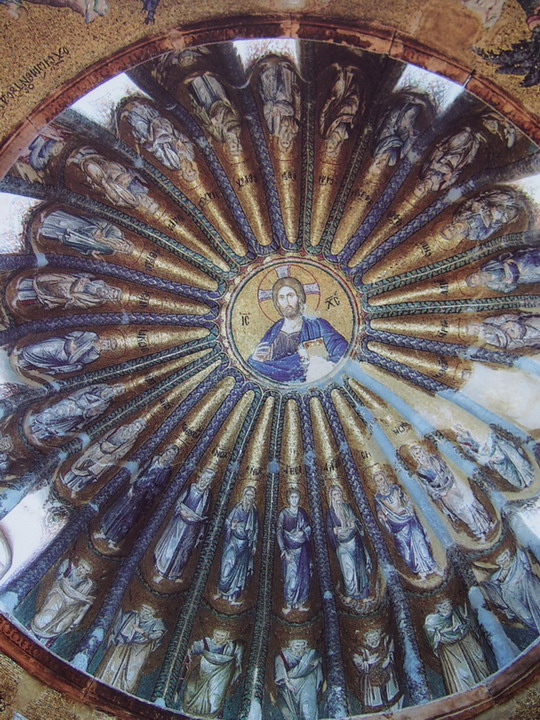
| Figure No. 2. Genealogy of Jesus Christ in the mosaics of the Chora Church, Constantinople, 2 part [12].
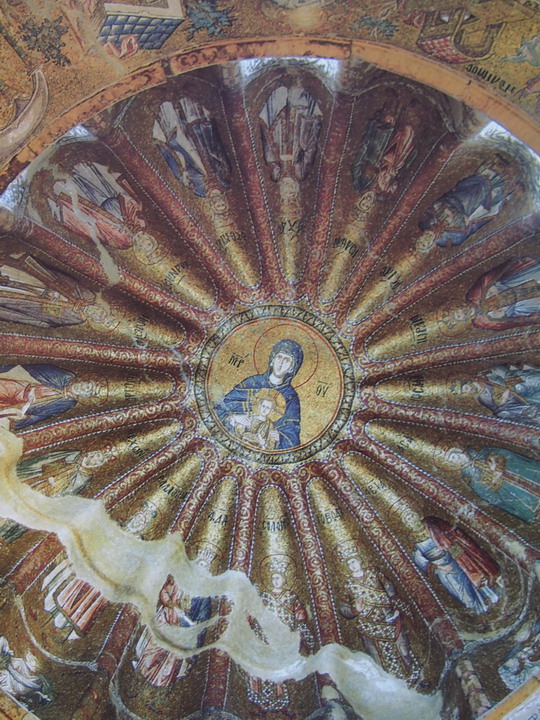
| 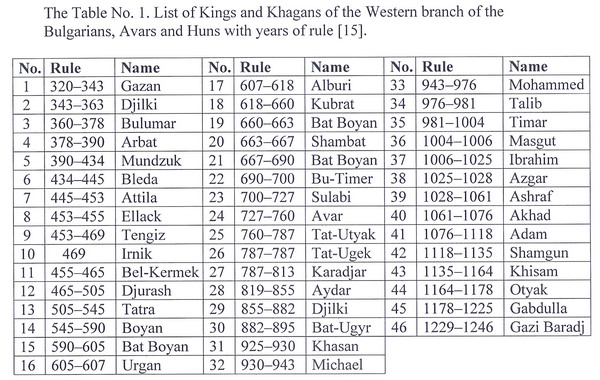
| 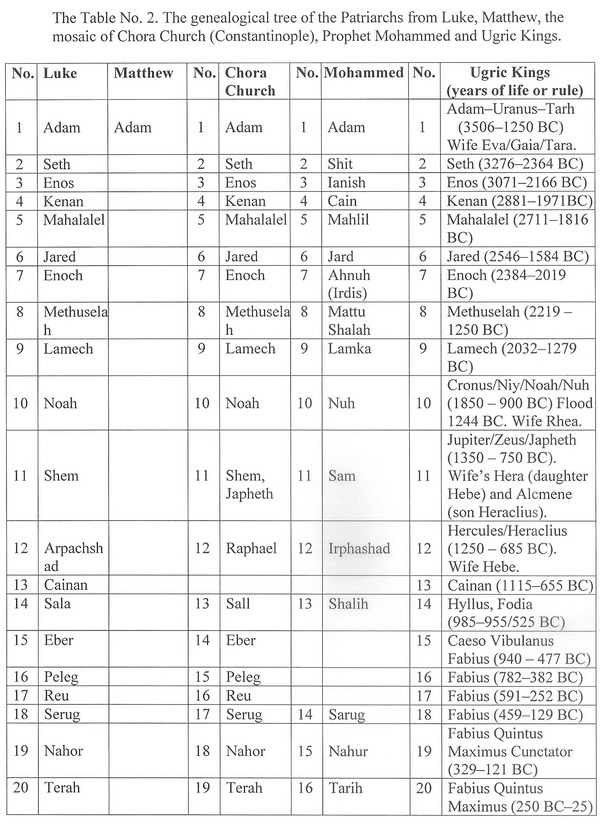
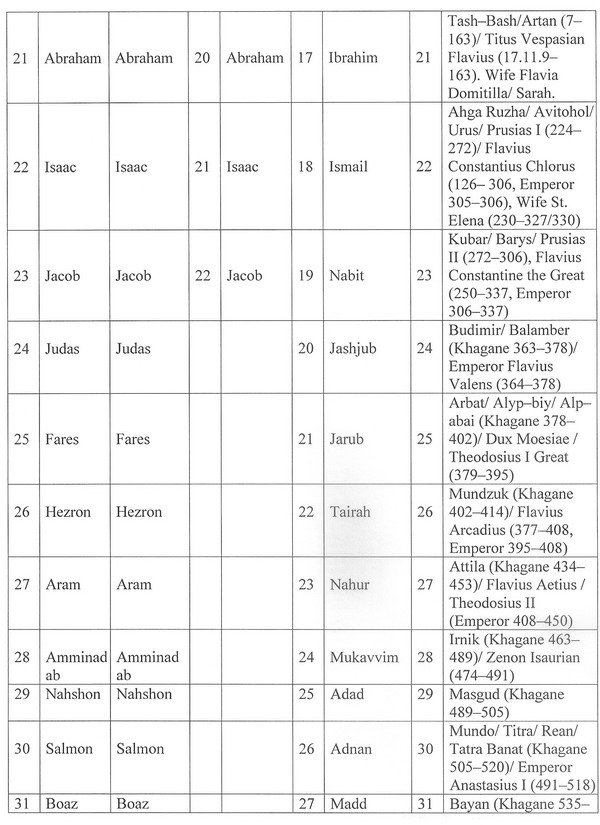
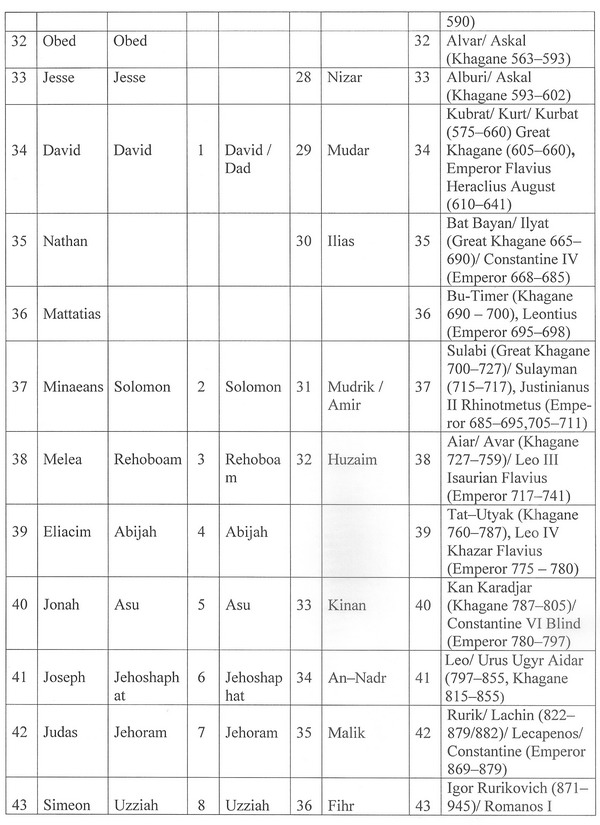
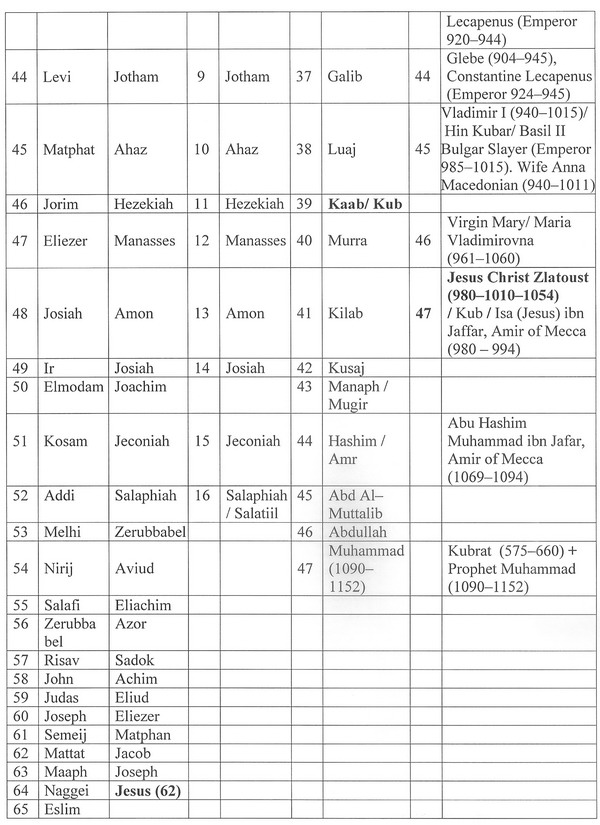
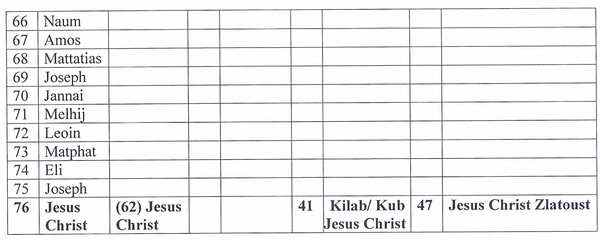
| According to the author's paradigm, God the Father of mankind is the Ugric, the forefather of the Russ and the Ugric people, Haplogroup N1. From the first physical children of the Father came the human race by genetic mixing of the children of God with terrestrial hominids of both sexes. The first generations of descendants of God the Father could live for hundreds years, and sometimes thousands years. The last centenarian in the 22 generation was the Khagan Ahga Ruzha / Red Ahga/ Avitohol, aka the Emperor Constantius Chlorus or Isaac.
Differences in the Patriarchs of mankind up to the 12th generation Hercules/ Japheth are not in different religions. After the Flood in 1244 BC or the Late Bronze Age collapse [16], the surviving Titans formed the Olympic Pantheon of gods, which settled on Mount Olympus aka Uludag near the city Prusa/ Bursa, on the Marmara Sea. All the Olympian gods were Ugrians, as were their sons.
The descendants of Heracles/ Hyllus/ Sala continued the direct line of God the Father on Earth. Patriarchs of the period of the first Millennium BC are very difficult to identify with real historical figures, as there is little information and artifacts. The work of identifying figures from this era is a complex task and is not yet complete.
According to the author's paradigm, the Heraclides were called in Roman history the Fodii, then the Fabii and Flavii. Fodia it is literally the diggers of the pits/Yam. However, the concept of Yam was difficult to translate into Latin. Ugric called small forts and fortresses Yams, not holes in the ground for catching wild animals. In modern Russia there are still many Yams, which later became known as post stations, and post riders – drivers. In fact, Fodii created a huge network structure for the development of free, unpopulated spaces.
In the history of Ancient Rome, several families of Ugric Heraclides are known. We are talking about Fodii, Fabii, Flavii, Claudii and Nero. Perhaps the Catones was among them. Traditional historiography claims that the choice of identical names for children in Roman patrician families (praenomen, nomen, and sometimes cognomen) became a tradition. The author believes this opinion is erroneous. In fact, we are talking about Patriarchs who lived for hundreds years, changing their cognomens over time. At the same time, their children, grandchildren and great-grandchildren could live with them, dying before the Patriarchs. According to this concept the Patriarchs Sala, Eber, Peleg, Reu, Serug, Nahor, and Terah are Fabians, including Fabius Vibulanus, Quintus Fabius Maximus, and Quintus Fabius Maximus Cunctator – Slow. Nickname Cunctator/ Slow coincide with the nickname of the Patriarch Terah.
It is difficult to identify the early Patriarchs with the Ugric Kings from the Bulgar Chronicles [15] and with Roman figures, since there was a Republic in Rome. There is only a list of Idel leaders without details of biographies and periods of rule. It is possible to identify Appius Claudius aka King Targiz (board 320–314 BC) the period for public office Appius and value of the individual Targiz, which has renounced power for the people vol. III, p. 86 [15] and died at the age of 120 years. Detailed information about the Patriarchs is available only from the beginning of Christian era [17, 18].
In the 7 one of the Patriarchs and Ugric Kings was born. His name was Tash Bash / Er-Tash Artan, son of Kubar (the Sun God), vol. III, p. 89 [15]. Death occurred in 150 or 163 at the hands of Agha Ruzha (Red)/Agar Jey, who was his son. Tash Bash managed to gain a huge reputation among people, which he began to actively abuse, affecting all aspects of the life of others – where and to whom to trade, etc. According to the author's hypothesis, the duel took place on the Temple Mount in El Quds/Jerusalem. The winner of the Agha Ruzha duel went with the army to the North Caucasus, becoming the King of the new Dulo dynasty.
The Roman Emperor Titus Vespasianus Flavius was born on November 17, 9 is the ethnic Sabine. Titus is one in three persons – himself and allegedly two sons. He reigned in 69–79, 79–81, 81–96. Rome elected an Emperor every year. He lived most of his life in Palestine, Arabia, and Egypt. He was recognized by the Romans as the first Great Pontiff of Christianity. He has wife Flavia Domitilla, mistress is Berenice, daughter of the King Herod Agrippa. There is a duplicate of Flavia Domitilla, allegedly her daughter and full namesake. On August 24, 79 the Mount Etna erupted, destroying the cities of Stabia and Herculaneum or Sodom and Gomorrah. The nickname Hagar is found in the name of Berenice Agrippina, and is also present in the name of Hagar's son Jey.
Abraham allegedly lived about 2000 BC a lifetime is 175 years, Genesis [11]. He was in Mesopotamia, Palestine, Egypt, and Arabia. He has Sarah wife and Hagar mistress. The children are Isaac by Sarah and Ishmael by Hagar. On the Temple Mount, an attempt was made to sacrifice the son Isaac to God, which was stopped by an Angel. A relative of Abraham named Lot found the destruction of Sodom and Gomorrah in brimstone and ashes.
According to the author's reconstruction of the history Tash Bash, Titus Vespasian Flavius and Abraham is one person. He lived about 157 years, date of death 163. Tash Bash/ Titus / Abraham were ethnic Sabine, an ethnic Ugric, Haplogroup N1.
Tash Bash / Titus / Abraham ruled and operated over a vast territory – from the Caspian Sea and the Caucasus to Egypt and Palestine. The first possibly only son was Ahga Ruzha (Red Aga), aka Agar Jey, aka Flavius Valerius Constantius Herculius Augustus Chlorus, who was nicknamed for his pungent red hair color.
According to the author's reconstruction Tash Bash / Titus / Abraham is the founder of the idea of Christianity. Together with son, he built the first Christian Temple Kaaba in Mecca around 150. The Patriarch died during a duel with son on Mount Temple in 163, when angels stopped his hand and allowed son to survive.
The next Patriarch of the Ugrians and all mankind was Ahga Ruzha/Agar Jey/Avitakhol of the Bulgarian Chronicles, the first King of the Khon dynasty of Dulo. According to [14] Avitohol lived for 300 years. We believe that he lived in the II, III and IV centuries. According to the author's reconstruction of the history Ahga Ruzha was born in 126 and died in 306. The wife was a Boyar-Kyz, who give birth Barys/ Kubar.
The Roman Emperor Flavius Valerius Constantius Herculius Augustus Chlorus is, date of birth unknown, died in 306 at Albion, near York. He was Emperor of Rome in 305–306. In the suburbs of the Prusa city (modern Bursa) Constantius met his common-law wife (concubine) Elena (230–327/330).
In the city of Prusa the Bithynian King Prusias I ruled for 48 consecutive years in the III century (244–272), and not in the III century BC [19]. The image of Prusias on the coins has been preserved. The profile of the King is completely identical to the image of the Emperor Constantius Chlorus on Roman coins of the IV century. Since then, the thrones of the Prusa city and Bithynia have become thrones of the Russ (Urus, Great).
The Biblical Isaac did not show anything special in a long life – more than 180 years. At the age of 37 there was an attempt to sacrifice him to God on the Temple Mount, but the angel rejected the hand with the dagger of father Abraham.
The author identifies the Ahga Ruzha/ Avitohol/ Constantius Chlorus / Isaac as a historical character who lived a very long life in the II–IV centuries in the expanses of Palestine, the Caucasus, Asia Minor, Europe and Britain.
The next character is Tucci Barys/Kubar, son of Agar Jey and Boyar–Kyz. The years of the government are not exactly known [15].
Prusias II (272–306) ruled Bithynia, "A friend and ally of the Roman people".
Constantine I the Great (Flavius Valerius Aurelius Constantinus) is an Emperor, years of life 272–337. He was born in Moesia (Moesiae). He became Emperor after his father death (306–337). He made Christianity the state religion. In 330 he moved the capital to the New Rome – Constantinople. The one nickname of the King is Kubanit, the Emperor's soldiers were called Kubanites/ Kubars.
Constantine defeated the pagan army of the Tyrant Maxentius in 312 at the confluence of the Laba River with the Kuban River. The author also identifies Constantine (the fourth ruler in those years) with George the Victorious [16]. He called the first Christian Ecumenical Council of Nicaea in 325, which adopted the Creed and condemned Arianism. He was baptized before his death. Together with mother he built the first Christian Church on the Temple Mount in Palestine.
Jacob/ Israel/ Yaqub / Nabit (Arabic) is the Patriarch of the Abrahamic religions. Jews and Christians interpreted the name Jacob as derived from the word "heel, footprint", although the Arabs simply called it I’m Cube. Jacob is a derivative of the name of the Father God Cube, called by the Bulgarians Kubar (Kub/ Cube is God of the Sun, Ar is head). For fighting with God in the river, he received the second name Israel, and revealed the 12 tribes of Israel to the world.
Kubar/ Barys/ Constantine The Great/ Jacob/ Yaqub / Israel are identified by the author as a single historical person who lived in the III–IV centuries. He declared Christianity the state religion of Rome, founded New Rome, defeated the pagan Serpent in the waters of the Laba and Kuban rivers, held the First Ecumenical Council in Nicaea, and approved the Nicene Creed. He gave to world 12 tribes of Israelites. By birth he is the Ugric King of the Khon dynasty of Dulo and Russ.
Budimir / Balamber/ Bulumar (363–378) are the first King of the II Khon dynasty vol. III, p. 89 [15]. Bulumar entered the legends of the Rusyns as Budimir (Judah/ Judas – a derivative of the Budi). Initiated and carried out a major military reform of the Bulgarian army, when the vanguard of the army called Urus [Great] Saban is the part of the army that begins the attack. Bulumar moved the capital of Idel from the Volga region to Kara-Saklan [Ukraine] to the headquarters of Kan-Balyn [the future Bashtu, Kiev], which he founded. The Kiev hill on which he was buried received his nickname Shake [Shchek, Shchekovitsa – in Rusyns].
Flavius Julius Valens II is a Roman Emperor; life is 328–378, reign 364–378. He allegedly died in battle with the troops of the barbarian Huns under the leadership of Budimir's son named Arbat on August 9, 378. Budimir was killed in the same battle. The death of the Emperor is not confirmed, because the body was not found. We are dealing with historical forgery, when in one battle historians brought together as opponents two hypostases of one historical person – is Roman and a Barbarian. The author found several other similar falsifications. In fact, in 378 there was a battle between the Huns (the commanders Budimir and Arbat) and Visigoths of Fritigern. Valens/ Budimir was buried on the territory of modern Kiev.
Judas is the fourth son of the Patriarch Jacob, after Judas allegedly named one of the Jewish States – the Kingdom of Judea. In the genealogy of the Prophet Muhammad is known as Jashjub.
We identify Budimir/ Valens II/ Judas/ Jashjub as one historical person, who lived in the IV century.
Arbat/Alyp-Biy/Alp-Abay (378–402), vol. III, p. 90 [15] is the eldest son of Budimir and Turan-Bika (Princess), he continued the Idel dynasty of Ijibaks and the I Khon dynasty of Dulo, but was also the successor of the II Khon dynasty of Dulo. He was born in 361. He ruled Idel for 24 years. He entered the legend of the Rusyns under the name Svyatogor and Solovey Budimirovic. He organized the first wave of the Migration Period/ Great migration of peoples – is Huns invasion from the Volga region and Siberia to Eastern and Western Europe in the 380th.
Theodosius I the Great Flavius (Flavius Theodosius Magnus) is last Emperor of the unified Roman Empire, life is 346–395, reign is 379–395. On January 19, 379 he was proclaimed Dux Moesiae and declared Emperor of the Eastern part of the Roman Empire. Theodosius Flavius first came to Constantinople in 380, where he issued the Edict De fide catholica on Christianity as the only state religion of the Roman Empire. In 381 he held the Second Ecumenical Council in Constantinople. In 391–395 he adopted an Edict banning paganism and prayer in pagan temples, canceled the Olympic Games. Since 355 the Obelisk of Pharaoh Thutmose III, brought there by the Egyptians, lay on the embankment of Constantinople. The Obelisk was allegedly created in the XVI century BC, but in 390 the Theodosius ordered to install an Obelisk on the Hippodrome. On the base of the Obelisk, he placed marble bas-reliefs depicting the struggle of chariots, a diagram of the installation of the Obelisk, and portraits of Theodosius himself with his family and entourage. The Hippodrome also had a copper Serpent Column made up of three bodies of writhing snakes. The Obelisk and the Serpent Column have survived to this day, with the exception of the serpent heads, which were cut off by unnamed Muslims on October 20, 1700.
Moses in the Pentateuch [1] is a Jewish Prophet and lawgiver, the founder of Judaism, who led the Exodus of the Jews from Egypt. He lived 120 years in the XIII century BC in Hebrew, Moshe means "taken from the water". His name is Musa in Arabic, Moses in English. The nickname is Moses, but in Orthodoxy Leader Moesiae is the name of the place. Moses sent on the Egyptians 10 executions, led the Israelites out of Egypt through the Black Sea (called by theologians Red Sea) at the bottom of the reservoir. He got 10 Commandments from God on Sinai Mount. Next to the mountain was the salt Lake Marah. He used a Copper serpent to fight snakes. After 40 years of wandering in the desert, Leader Moses died.
We identify Arbat/Theodosius the Great/Moses as one man. His life time 345–402, the board is 378–402. In 378 Arbat led the first overpopulation of Israelis/ Kubanits, residents of the Volga Ulak Urum/ Itil/ Ancient Rome in the number of 600 thousand people. On January 19, 379 the Ugric King Arbat transferred refugees across the frozen Black Sea ice near the Tuzla spit from Kuban to Crimea – is the true Sinai. The migrants were pursued by the troops of the Pharaoh Thutmose III, who settled in Itil/ Rome/ Memphis on the Akhtuba in 324. The weakened ice from the refugee carts collapsed under the chariots of the Pharaoh's army, and most of the pursuers drowned in the Black Sea. Kubanites got to Sinai (Crimea), where Arbat received the Tablets of the Covenant with God on Mount Roka Ai–Petri. For many months, the refugees tried to find a way out of the Crimea to the mainland, but ended up in the salt Lake Siwash (Lake Marah). Soon a passage to the North was found. This scythe is still called in honor of the King Arbat – the Arabat Arrow. The former Kaffa was named in honor of the Emperor Theodosius the Great – is the Feodosia city.
Then the Kubanites/ Bulgarians/ Israelis were transported to the Balkans and reached Europe. Only in 380 Arbat/ Theodosius arrived Rome, where he became Emperor of Rome. For his military feat Arbat / Theodosius received the Roman military Title Dux Moesiae and was proclaimed Emperor. The word Moses became a household name, and people began to use it as a term meaning the name of the Prophet. The name of the province of Moses (Moesia) became synonymous with Salvation, is the Promised Land. This is why the Saviors have been called Messiahs ever since.
Arbat/ Moses, as an act of reconciliation with the pharaohs of Egypt, installed an Obelisk of Thutmose III on the Hippodrome, married one of the Egyptian Princesses, and married his daughter, possibly Gallus Placidia, to the Pharaoh. The invasion of the Huns in Europe during the reign of King Arbat in the 380th is the Exodus of the Israelites from Egyptian captivity and the large-scale migration of the ancestors of modern Europeans from the Volga region and the Caucasus.
Attila/ Aetcel/ Tuki/ Aibat/ Tukal/ Tokhol are the Ugric King in 434–453, vol. III, p. 91 [15]. He is son of Mundzuk/ Menchac of the most famous Bulgarian King and conqueror. He born in 401 and was co-ruler in 434–445, and then sole ruler of Idel. During his reign, the Power became the largest Empire in the history of mankind, from China to France. During the reign of his son Tingiz, Idel split into Kara-Bershud [the Danube and Dnieper parts], Ak-Bershud or Echke Idel, Inner Idel [the Volga-Ural part of Idel] and Eskel [the Siberian part of Idel]. The deeds of Attila are well known; chroniclers called him the scourge of God. Attila led the second wave of Exodus or Great Migration Period in the 440th.
Flavius Aetius is General of the Western Roman Empire, was awarded the epithet the last of the Romans by historians. He was killed in 453 or 454. It is considered a participant in the battle of the Catalan fields and the winner of Attila in 451. At the same time, the name Aetius is identical to one of Attila's nicknames – Aetcel.
Theodosius II Flavius is the Emperor of the Eastern Roman Empire for 48 years. From 402 he was the minor co-ruler of father Arcadius, and from 414 his sister Pulcheria actually ruled as Regent and Augusta. Then his wife Eudoxia and the eunuch Chrysaphius ruled. It is believed that Theodosius II did not deal with the Affairs of the Empire, and entrusted the rule to his relatives and courtiers. Emperor died in an accident in 450.
Joshua is the Biblical Patriarch, the successor of Moses. He is the leader of the Jewish people during the conquest of Canaan. The acts are described in detail in the Book of Joshua [11]. He won the Promised Land for the Israelites. He showed an unheard-of cruelty and ruthlessness to his enemies. In one of the battles, he performed a miracle, stopping the movement of the sun and moon, in order to destroy all the enemies. After the conquest and division of the land, he died peacefully on mount Ephraim.
We identify Attila/ Flavius Aetius/ Theodosius II/ Joshua as one historical person who lived in the V century. In fact, the Promised Land for the Israelites / Kubanites is the Central and Eastern Europe and the Balkans, which were captured by the Huns/ Romans from the Volga region.
After the collapse of Attila's Empire, there was a period of judicial rule in Bulgar/ Idel described in the Bible. Then one of the Judges ruled is Saul, who became first King of the Israelites. Let's identify King Saul with the Ugric King.
Before Kurbat grew up, the Power was ruled on his behalf by Alburi wife's brother is Yurgan (Burgan) Teles (602–605), vol. III, p.95 [15], who was Kubrat's uncle. The Danube Bulgarians called Yurgan as Organ (617–630). There is chronological shift of the time of the reign of King Yurgan Teles/ Organ in Bulgarian and Roman sources by 10–15 years.
Yurgan had to re-create the Bulgar State, which collapsed after the death of Alburi into 60 Shires (Tuba). When Kurbat matured, Yurgan voluntarily handed over power to him. Yurgan's life went down in Bulgarian history as an example of selfless service to the people and his native country. After the death of Yurgan Teles, King Kurbat was served by Yurgan's son is Bilig. In one of the battles, Bilig, saving Kurbat, died, and Kurbat adopted his two sons – Lachyn and Kyzyl-Kubar. Before ruling as a Khagan, Yurgan Teles served as chief Judge [idjik or idik in Bulgar]. In 619 in order to consolidate the Union with the New Rome, Yurgan accepted Orthodoxy with a part of the Bulgarians in the Byzantine city of Korsun (Chersonesus). At the same time, the vicissitudes of the life of Khagan Alburi / Askal are superimposed on the biography of Yurgan.
Flavius Phocas Augustus is a usurper and Emperor, life is 547–610, reign is 602–610, killed or committed suicide in 610. Phocas was elected Emperor by the mutinous troops. Phocas reign was marked by a series of extrajudicial killings and brutal executions. It is said that Phocas was torn to pieces with the nobles by an indignant people. The reason for the massacre of the tyrant was the entry into the Bosporus in early October 610 of the fleet under the command of Heraclius I.
King Saul is a Biblical figure, the founder of the United Kingdom of Israel, the Old Testament [11]. Jews believe that the name Saul means "borrowed from God". In the Quran, Saul is called Talut [20], the Cow, 2:247–251. The names Talut and Teles are similar in spelling. According to one version, which is considered the closest to the historical truth, Saul is a military commander who was proclaimed King in Gingal after defeating the Ammonites. In the story, he is one of the Judges (heroes chosen by God). He lived about 1000 BC. It was believed that he had the gift of prophecy. The King's character was complex and explosive. At the end of his life, in one of the battles, Saul was wounded and committed suicide.
We identify Yurgan Teles/ Phocas / Saul/ Talut as one historical person who lived in the VI–VII centuries. The ruler was originally a judge of the Bulgarians/ Israelites, who then became Emperor for a time. He was not the heir to the throne, so his rule was illegal from the point of view of the Flavius/ Dulo/ Russ clan. Let us note once again that the history of the Bulgars and Huns is actually the primary basis of events in the Chronicles of the Byzantine Empire and the Holy Scriptures of the Old Testament.
Kubrat/ Kungrat / Kurbat/ Kurt/ Khor (live is 575/593–660, reign 618–660) are the eldest son of Khagan Alburi, vol. III, pp. 95–96 [15]. The Ugric King Kubrat was born in the Porphyry Hall of the Palace in Constantinople, where only Emperors was born. Until the age 12 he lived in the Imperial Palace, was baptized and received the Title Caesar/ Emperor. This information is available in the official historical records. During his lifetime Kubrat created a huge Empire called Great Bulgaria by the Bulgars. In 620 his younger brother Shambat rebuilt the city of Bashtu on the site of the Askal fortress. The future Kiev city stood on hills that were called the Bulgars is Kuyan or Kuk-Kuyantau [mountains of the spirit of Kuyan or Kuk-Kuyan], so Kiev is also Kuk-Kuyan. According to the author's reconstruction, the name Kiev came from the word Cube/ Kub, because the Arabs and Bulgars called the city Kuyab.
The Kubrat Empire is Greater Bulgaria or Greater Israel – extended from the Yenisei to Central Europe, vol. II, p. 16 [15] and from the Baltic Sea to the Red Sea. In 629 the Turkic Khaganate collapsed into two parts – Balasagun (Central Asian and Mongol) and Khazar (Western Kazakhstan), after which Kurbat immediately subordinated the Suvarsky beylik to his power and in 630 declared the newly united parts of Idel a single Bulgar Kingdom (Bulgar, Bulgaria). From now on the territory of the Volga region forever received its historical name – Bulgar or Bulgaria, and the name Idel was assigned to the Volga-Kama river system and the names of the seven largest rivers of this system began to add the word Idel. Kara-Idel is the Volga. Ak-Idel is the White river. Chulman-Idel is Kama. Sura Idel is the Sura River. Aka Idel is an Oka River. Nukrat Idel is the Vyatka River and Bula Idel is the Cheremshan River. The state of Bulgars was also called Kara-Bulgar that is Great Bulgaria. The capital of the state became Phanagoria is the city of the former Bosporan Kingdom.
Kubrat had five sons is Bat Bayan (Ilat-bir), Kotrag, Asparuh, Kuber and Alcek. Bat Bayan inherited the throne of Great Bulgaria. Kotrag headed the Volga Bulgaria. Asparuh became the Khan of Danube Bulgaria. Alcek and his Horde moved to Central Europe and remained in Northern Italy. The branch of the Roman Emperors was continued by the descendants of Bat Bayan. The third son Asparuh founded the dynasty of Kings of Danube Bulgaria. Kuber's descendants were Saints Cyril and Methodius, Rurik's cousins and spiritual fathers who baptized him in Itil in 860.
Flavius Heraclius Augustus is a Byzantine Emperor, the founder of a dynasty that ruled for more than 100 years. His years of life are 575–641, years of government 610–641. It is believed that the reign of Heracles, shamefacedly called Iracliy by Russian historians, opened a new era in the history of New Rome, as "the boundary between the old and the newly born historical movement", p. 3 [21]. The young Emperor came to the throne of Rome by overthrowing the Tyrant Phocas in 610. It is believed that Heraclius was a close friend of Kubrat, with whom he studied together. This position is surprising, because according to the traditional chronology, Heraclius must be 20 years older than Kubrat. It is believed that childhood friendship led to the conclusion of a peace Treaty between the great Kubrat Bulgaria and New Rome under the leadership of the Emperor Heraclius.
The main enemy of the Emperor and New Rome were the Persians, who captured Syria in 611 and in 614 the Palestinian El Quds (Jerusalem), whose inhabitants were captured and sent to Babylon. The Emperor spent much of his time on military campaigns in Asia Minor, Palestine, Egypt, and Arabia until 628. At this time, a new Muslim calendar the Hegira appeared, dating from September 24, 622. Heraclius in 616–626 ordered the restoration of the Christian Church built by his ancestors in the 330th Equal-to-the-Apostles Saints Constantine and Helen on the Temple Mount.
King David is the Second King of Israel the name translates as "beloved". Reigned 40 years in the X century BC. He created the Great Israel in the outlines of the Promised Land. David was the image of an ideal ruler, from whose line the Messiah would descend in the male line. He began the construction of the Temple, which was completed by his son Solomon.
We identify Kubrat/ Heraclius/ David/ Dad/ Mudar as one historical person who lived in the VI–VII centuries. Some differences in the biographies of the rulers are caused by the stormy work of Theophanes the Confessor and the theologians of the Khazar Khaganate. Great Bulgaria and Great Israel are one state created by the Kubanites/ Bulgars in the expanses of Europe, Africa and Asia Minor. Part of Israel fell on the territory of Palestine, which included the town of El Quds and Syrian Damascus. Soon the fragment of Great Bulgaria is the Umayyad Empire will become an independent state. The author believes that Kubrat / Heraclius became the prototype of the personality of the Prophet Muhammad (571–632), although the real Prophet lived in the XI–XII centuries.
Sulabi is a son (or grandson) of Bat Bayan or Bu-Timer, grandson or great-grandson of Kubrat vol. I, p. 23 [15]. Another name of Bat Bayan was Ilat-bir, which coincides with the Arabic name Ilyas (Forefather) in the genealogy of the Prophet Muhammad. Ilat was born in 617. In 643 he converted to Islam, performed the Hajj, and visited the Caliph Omar, whose name he took for himself. Since that time, the people began to call him Bat-Umar or Kamyr-Batyr (Umar, Kamyr is a form of the name Omar). After the Arab attack on Bulgaria in 654, the Khan renounced Islam. In the same year he defeated the army of the Arab commander Abdurrahman at Sarkel and received the nickname Ghalib (the Winner). In 674 his uncle Shambat took power from him for 3 years, and then Shambat died in 677. In 682 Omar converted to Christianity, and died in 683, and was buried in Bashtu (Kiev). Perhaps Bat Bayan and Bu-Timer is the same person.
After the death of Bu-Timer, the Khagan Sulabi headed the Kara-Bulgar and informed everyone about the permission of Tengri for his 45-year reign. Sulabi unlike his father disliked war and tried to avoid it. On the other hand, the King willingly engaged in commercial affairs and made the land and water roads running into Avar Khaganate, Artan, Rum [New Rome], Djalda, Saber and Kashek, vol. I, p. 23 [15].
Justinian II Rhinotmetus Flavius is a Byzantine Emperor, the last representative of the Heraclius dynasty. He is life on 669–711, years of government is 685–695 and 705–711. He held the Ecumenical Council in Trullo in 691–692. He got nicknamed Rhinotmet for his physical deformity in 695, the rebel General Leontius cut off the Emperor's nose and tongue. After this, Justinian fled to Phanagoria, then through the Khazars to Great Bulgaria, where he hid for seven years. In 705 he arrived to Constantinople with the Bulgarian army of Khan Tervel and regained power. He fought with the Arabs in Asia Minor. The usurper Philippikos Bardanas captured the Emperor Justinian on December 11, 711, and killed him by cutting off his head. Justinian's daughter was married to the Khan Tervel.
Sulayman Ibn Abd al-Malik (674–717) is an Umayyad Caliph in 715–717.
King Solomon is the third Jewish King, ruler of Great Israel in the X century BC [11]. The name means "peace". There are other names given to the Governor – Agur, Bin, Itiel' and Jedidiah (beloved of God). He is son of King David and Bathsheba. During the reign of Solomon, the Jerusalem Temple was built – the main Shrine of Judaism (on the Temple Mount). No historical evidence of the existence of Solomon has yet been found. The gods gave the ruler unprecedented wisdom and patience. He died at the age of 62 while overseeing the construction of the altar of the Temple in Jerusalem.
We believe that Sulabi/ Justinian II Rhinotmetus / Solomon / Mudrik (Amir)/ Sulayman Ibn Abd al-Malik is a historical person who lived in the VII–VIII centuries. In the reign of Sulabi/ Justinian II in 711 the construction of the Jerusalem Temple on the Temple Mount was completed, which still stands today. The construction of the Temple was started in 616–626 by the grandfather of Sulabi / Justinian II named Kubrat / Heraclius. The sanctuary is made in the form of an octagonal star of Russ, formed by projections of two bases of regular pyramids on a plane. The Temple has the name Qubbat As-Sakhra or Cube Rock. Shrines and structures in Arabia and Damascus are also named after Kubrat (such as the Quba Mosque, Kubrat Treasury, and Kubrat Fountain).
According to the author's reconstruction of history, the close friendship and military Alliance of the Emperor Justinian and the Bulgarian King Tervel is not surprising. They were each other's first cousins. The relationship was strengthened by the wedding of Anastasia's daughter and King Tervel. Sulayman was the Caliph of the southern part of Great Bulgaria/ Great Israel. Consequently, the rulers of the Umayyad Caliphate (661–750) were a branch of the Ugric Kings, coming from Kubrat, through his son Bat Bayan/ Omar and the grandson of Sulabi / Sulayman. At the height of its power, the Umayyad Empire stretched from Spain (Cordoba) and North Africa all the way to Central Asia and India.
After the Patriarch Sulabi/ Solomon the family trees of Jesus Christ (from Luke, from Matthew, and from the Chora Church) and the Prophet Muhammad, are differences begin. We believe it is correct to follow the genealogy of the Prophet Muhammad, since the tree is based on the Bulgar – Ugric Kings and Khagans, who were both Emperors of New Rome.
Christian and Jewish traditions trace the genealogy of Jesus Christ to his named father Joseph, which is erroneous. It is correct to trace the genealogy to the Mother Mary, because the father of Jesus Christ will be the Father of the Heavenly Cube (Kubar). In this way, the genealogical line of Joseph according to the Gospel of Luke and Matthew, which differ from each other, becomes speculative, and according to the author is a late insertion and forgery. There is no chronicled information about these Jewish Kings and Prophets. According to the author's reconstruction of history, following the family tree of Jesus Christ according to Luke suggests that Jesus Christ would have been a contemporary of Napoleon.
The mosaic images of the ancestors of Jesus Christ in the Chora Church are not arranged in a circle one after the other from father to son, as in the Gospel from Luke or Matthew. It turns out that the Kings Prophets are listed according to their religious significance, and not in chronological order. When comparing the names of Kings Prophets in the Christian and Muslim traditions, it turns out that they generally coincide before David and Solomon. Then the names of the ancestors in the genealogy of the Prophet Muhammad have a significant correlation with the names of the Ugric Khagans: Ilyas/ Ilat, Sulayman/ Sulabi, Huzaim / Ayar, Kinan/ Kan Karadjar, An-Nadr/ Aidar, Fihr/ Igor, Galib/ Gleb, Luaj/ Vladimir, Kub / Kubar (Vladimir's middle name) and Murra/ Maria.
Note that An-Nadr is the founder of The Quraysh family that is the incarnation of Alp Kuri/ Buri (the deity of war, valor, hunting and the wolf) and a descendant of Romulus/ Quirinus. We identify An-Nadr with Ugyr Urus Aidar (Great Horseman Igor) he is in the baptism Leo and the son of the Emperor Constantine the Blind. Soon Leo, due to problems with his grandmother Irene, the loss of the throne of Rome and the tragedy of his father, abandoned Christianity and converted to Islam.
The next important point is the double mention in the genealogy of the Prophet Muhammad of the names Vladimir / Luaj and Kaab / Kub. The Pagan or Bulgarian name of Vladimir was Kubar. After the Kub come the name Murra, which we attribute to the woman Virgin Mary. Maria's physical parents were Prince Vladimir / Kubar and Anna Macedonian, Empress of New Rome. The monk Joachim is Bishop of Korsun (Chersonesus) and later of Great Novgorod, became the spiritual father of Mary. Hence in the Bible have the names of parents Anna and Joachim. Joachim wrote a Chronicle and built the Church of Joachim and Anna in Great Novgorod, which was demolished by the Empress Catherine II Great. Our Lady Mary was one of the wealthiest and most influential women of her time.
Jesus Christ Zlatoust (Chrysostom) was born in 979/980, crucified in New Rome on Mount Beykoz on March 18, 1010 died of old age in China, and was buried under the name Confucius in Shandong province, Qufu city in May or July 1054.
Further, a contemporary in the author's reconstruction of the Lord Jesus Christ is his namesake Isa Ibn Jafar, Emir of Mecca (980–994). We believe that Jesus was recognized as the Savior and Emir (Sharif) of Mecca from the moment of his birth, but then the Muslims doubted this and withdrew their decision. According to the author's reconstruction of history [15], Jesus Christ Zlatoust had at least 12 children from different wives around the world. Therefore, the Prophet Muhammad is a direct descendant of Jesus Christ Zlatoust in Arabia. The great-grandfather of the Prophet Muhammad was the Emir of Mecca Abu Hashim Muhammad Ibn Ja’far (1069–1094), who was the great-grandson of Jesus Christ. The grandfather and father of the Prophet Muhammad were no longer Kings or Emirs (Sharifs).
The analysis of the genealogical trees of Jesus Christ and the Prophet Muhammad proves the presence of interference of theologians and religious figures in the writing of these and the free interpretation of events and historical figures that are the prototypes of religious Prophets. The Jews sought to turn the Patriarchs into Jews by giving them their religious names, and the Muslims added their own Arabic flavor to justify the greatness of their religion. However, in reality the Kings Prophets could only be the leaders of Empires and numerous peoples who carried out the migration of population and religious ideas in the direction of the Volga region to the South and West. For the most part the Patriarchs were the Kings of the Ugrians, Haplogroup N1, who had a direct relationship from father to son. A smaller part of the Patriarchs recognized the Germans, Haplogroup R1b1, and possibly the Indo-Europeans, Haplogroups I1 and I2. After the death of the Prophet Muhammad in 1152, a significant influence on Islam was exerted by the Sayyid – the Prophet's female relatives. It is obvious that the Arabs began to record ancient families in the Quraysh clan, which had nothing to do with Ugric Kings.
To establish the truth, it is necessary to conduct thorough research on the DNA of the alleged Quraysh and the remains of the Prophet Muhammad or his son Ibrahim.
The author considers it correct to estimate the time of creation of the monotheistic Scriptures: the Old Testament was written in the IV–IX centuries; the Talmud in the VII–IX centuries; the Torah in the VII–IX centuries; the Gospels in the XI century; the first Ayahs and Surah were written in the X–XII centuries; and the Quran was written in 1130–1152. According to the Chronicles of Bulgar [15], the first oath on the Quran was given only in 1178.
The author's identification is justified [9, 10] by a whole galaxy of unique astronomical phenomena (15 events) described in the Scriptures and world Chronicles. This includes the Eclipse of the Sun on March 18, 1010, during the Crucifixion of Jesus Christ, and the Eclipse of the Sun on February 07, 1152 on the day of the death of Ibrahim, the son of the Prophet Muhammad.
| Conclusions of our research: The Author's paradigm of the short history and chronology of religions [5–10, 17, 18] is fully confirmed by the identification of the Patriarchs of monotheism with real historical figures of the past. All the studied individuals turned out to be Ugrians, Haplogroup N1. The author identified the Patriarchs from the son of Raphael/ Hercules to Terah as Fodius and Fabius, and starting with Abraham as Flavius. The Patriarchs from Abraham identified (the names is religious, Ugrian and Byzantine) as Kings: Abraham/ Tash Bash/ Titus Vespasian; Isaac/ Ahga Ruzha/ Constantius Chlorus; Jacob / Kubar/ Constantine the Great; Judah/ Budimir / Valens; Moses / Arbat/ Theodosius the Great; Joshua/ Attila/ Theodosius II; Saul/ Yurgan Teles/ Phocas; David/ Kubrat/ Heraclius I and Solomon/ Sulabi / Justinian Rhinotmetus. Our Lady Mary was the daughter of Prince Vladimir and Anna Macedonian, and her foster father was Bishop Joachim. Jesus Christ Zlatoust was born in 979/980, was crucified in Constantinople on Mount Beykoz on March 18, 1010, and died of old age in China under the name Confucius in the province Shandong, Qufu city in May or July 1054. The Prophet Muhammad became an integration of two historical figures – Khagane Kubrat (575–660) and Prophet Muhammad (1090–1152). Pr. Dr. Valeriy Viktorovich Kubarev, 21.07–27.08.2020. Full text of the article at the link: http://www.kubarev.ru/en/content/504.htm | Bibliography: 1. Gimbutas, M. (1964) Bronze Age Cultures in Central and Eastern Europe. Mouton.
2. Gimbutas, M. (1977) The first wave of Eurasian steppe pastoralists into Copper Age Europe. J. of Indo–European Studies, vol. 5.
3. Gimbutas, M. (1974) The God and Goddesses of Old Europe. 7000–3500 B. C.
4. Gimbutas, M. (1980) The Kurgan wave № 2 (c. 3400–3200 B. C.) into Europe and the following transformation of culture. J. of Indo–European Studies, vol. 8.
5. Kubarev V.V., Vedas of Russ, IP MEDIA, M., 2009. ISBN 9781-93252567-0. Link: http://www.kubarev.ru/en/content/251.htm
6. Kubarev V.V., Short Chronology of Ancient Egypt, EESA, #6 (46) 2019, Part. 4, pp. 30–58.
7. Kubarev V.V., Localization of Ancient Rome, EESA, #7 (47) 2019, Part. 4, pp. 28–59.
8. Kubarev V.V., Chronology of monotheistic religions, EESA #8 (48) 2019, Part. 6, pp. 31–67.
9. Kubarev V.V., Astronomical dating of Biblical events, EESA #3 (55) 2020, Part. 2, pp. 24–35. Link: https://eesa-journal.com/wp-content/uploads/EESA_3_55_march_2020_part_2.pdf
10. Kubarev V.V., Synchronization of historical and religious Chronicles, East European Scientific Journal (Warsaw, Poland), #5 (57), 2020 part 5. pp. 21–30. Link: https://euroasia-science.ru/wp-content/uploads/2020/06/Euroasia__574_11_may_2020.pdf
11. Bible. The Gospel of Luke (Chapter 3), the Gospel of Matthew (Chapter 1).
12. «Айя-София и Карие», Text Ali Kilickaya, photos Erdal Yazici and Ismail Kucuk, Doga Basim, Turgut Ozal Cad. Celik Yenal is Mercezi, No. 117 Ikitelli – Istanbul. Copiring Silk Road Publications, Istanbul – Turkiye, ISBN 978-605-5629-16-8.
13. Ибн Хишам «Рассказанное со слов аль-Баккаи, со слов Ибн Исхака аль-Мутталиба» (утверждается, что это первая половина VIII века). Перевод с арабского языка Я. А. Гайнуллина 2002, Издательский дом «УММА», 2003.
14. А. Н. Попов, «Обзор хронографов русской редакции», Москва, 1866 год. Именник Болгарских Ханов.
15. Бахши Иман, Джагфар Тарыхи (Летописи Джагфара) Гази–Барадж Тарыхи (Летопись Гази–Бараджа), I – III том. Бахши Иман. Джагфар Тарихы. Свод булгарских летописей 1680 г. / Изд. подготовлено Ф. Г.-Х. Нурутдиновым. Оренбург: Редакция Вестника Болгария, 1993.
16. M. Liverani, «The collapse of the Near Eastern regional system at the end of the Bronze Age: the case of Syria», in Centre and Periphery in the Ancient World, M. Rowlands, M.T. Larsen, K. Kristiansen, eds. (Cambridge University Press) 1987.
17. Kubarev V.V., Attribution of Rurikovich and Lakapenos Emperors, Report at the XXVIII International conference on problems of Civilization, 26.04.2014, Moscow, RosNOU. Link: http://www.kubarev.ru/en/content/402.htm
18. Kubarev V.V., Origin of the gens Rurik, East European Scientific Journal (Warsaw, Poland), #10 (50), 2019 part 9. pp. 9–39. Link: https://eesa-journal.com/wp-content/uploads/EESA_1050_oct_2019_part_9.pdf
19. Рыжов Константин, Все монархи мира: Древний Восток», Вече, 2001.
20. Quran.
21. Успенский Ф.И., История Византийской империи, Том I, М., Издательство Астрель, 2005, стр. 600.
Full text of clause in format World:
18841.docx
|
Gallery of images of Patriarchs and their corresponding historical figures: | 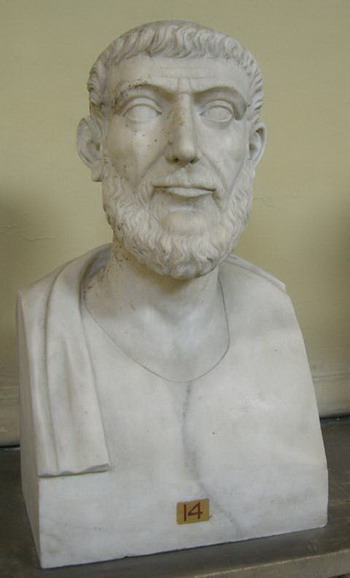
Appius Claudius (the Carrot), which were the sons
Russ, Nero and Pulcher, IV century BC.
| 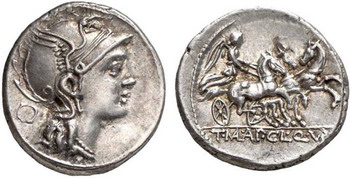
Pulcher (Beautiful) of the Appius - Russ Family
| 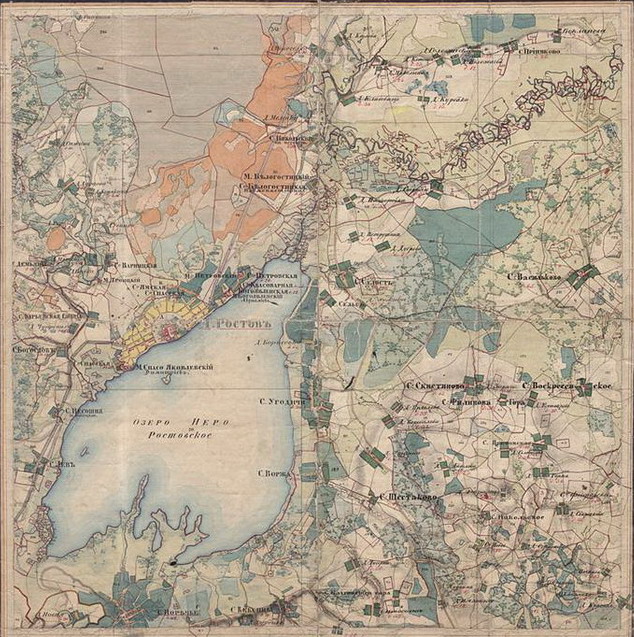
Lake Nero, near Moscow. Ancestral home of Appius and Russ.
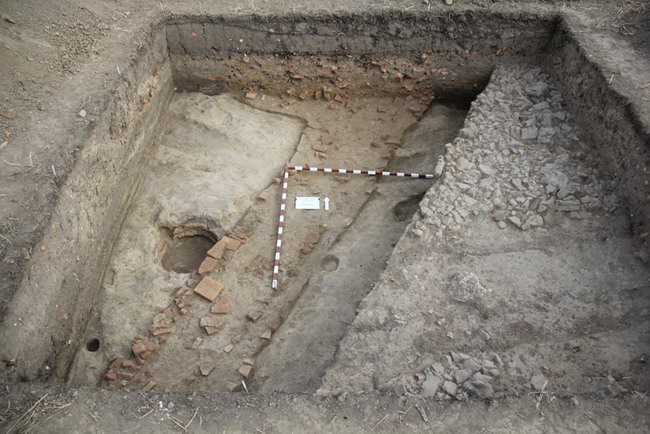
Excavations of the Roman Appian road - part of the Northern Silk road in Kuban.
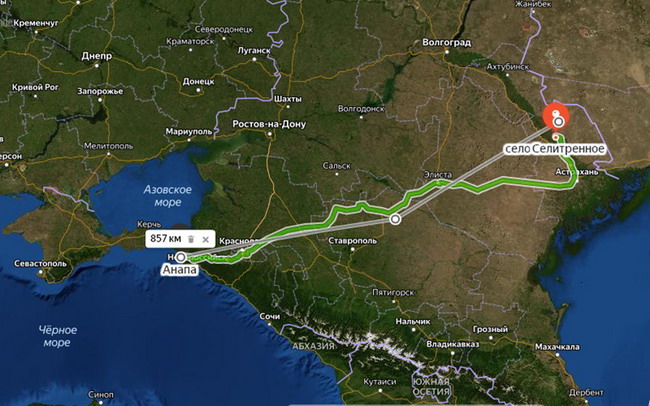
Map of the modern road (green) from Akhtuba to Anapa and a possible version of the Appian road
(gray) from Rome on Akhtuba to Anapa (passes through the Pontic swamps in the Kuban).
| 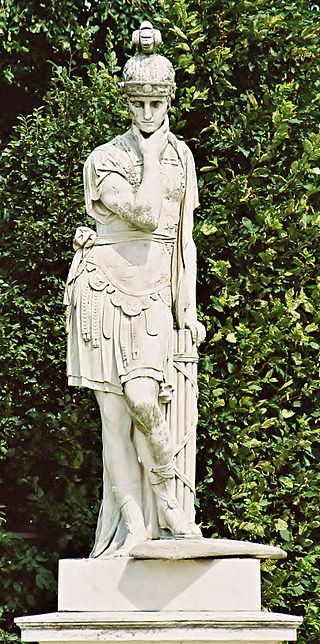
Quintus Fabius Cunctator (Slow).
| 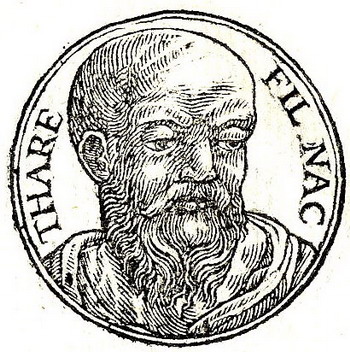
The Patriarch Terah (Slow).
| 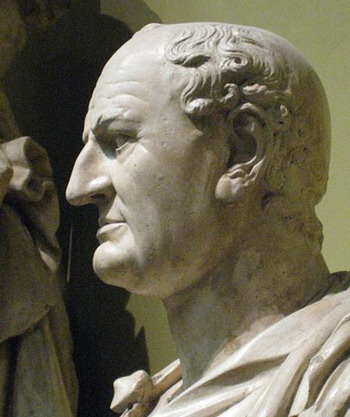
Abraham, he's the King of the Tash Bash, aka
the Emperor Titus Flavius Vespasian.
| 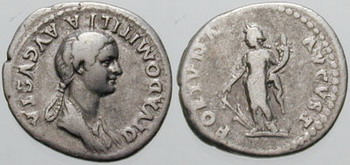
Flavia Domitilla, aka Sarah, wife of Abraham.
| 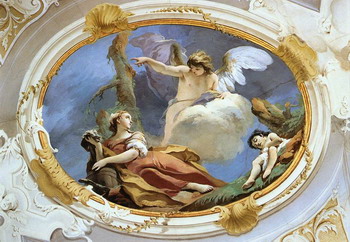
Hagar
| 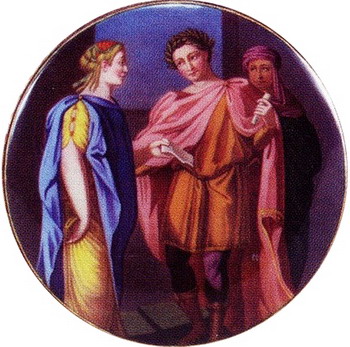
Berenice Agrippina (Hagar).
| 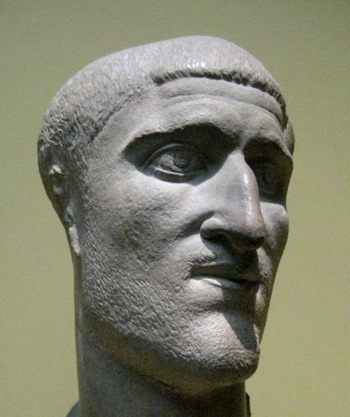
Isaac, he is king Aga Ruzha, it's the king
Prusias I and the Emperor Constantius Chlorus.
| 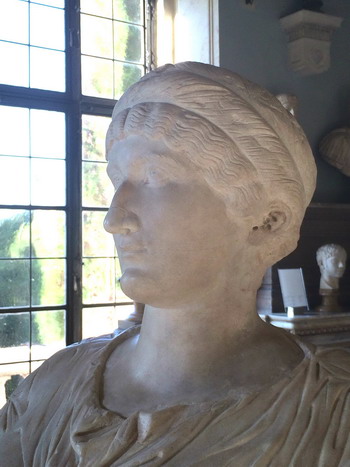
Rebecca, aka Saint Helena
| 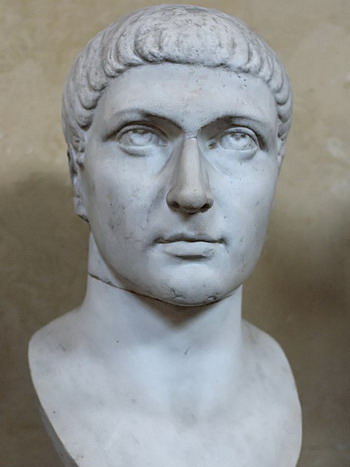
Jacob/Israel, he's king Kubar, aka the king
Prusias II and the Emperor Constantine the Great
| 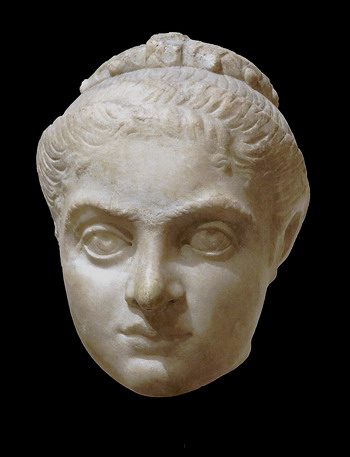
Jacob's wife Leah or Rachel,
aka Fausta
| 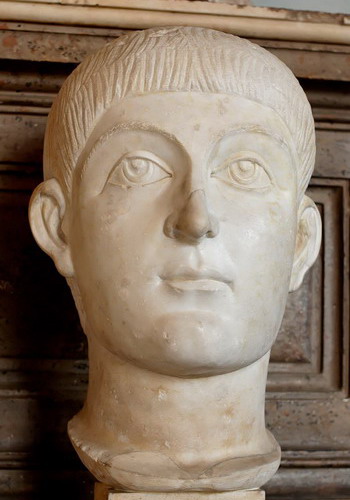
Judas, aka Khagane Budimir,
aka the Emperor Valens.
| 
Judas, a biblical character.
| 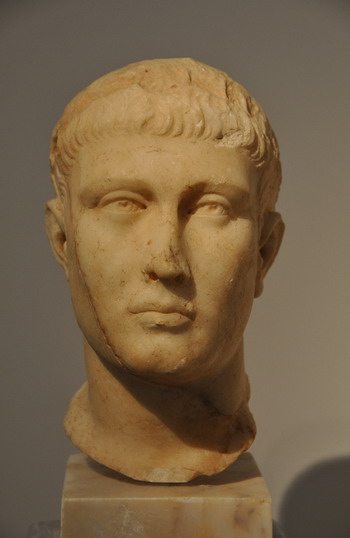
Moses, who is also the Dux Moesiae, aka Khagane
Arbat, aka Emperor Theodosius the Great.
| 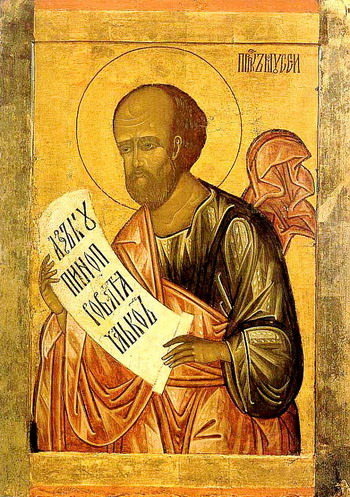
Moses, who is also the Leader Moses.
| 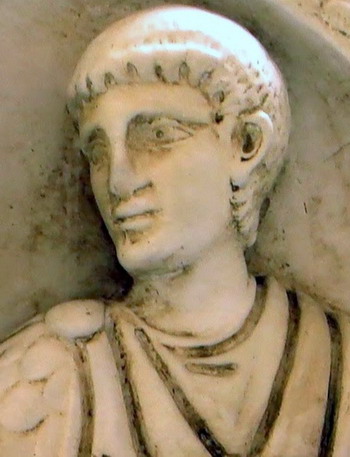
Joshua, aka the Khagane Attila, it Flavius
Aetius, aka Emperor Theodosius II.
| 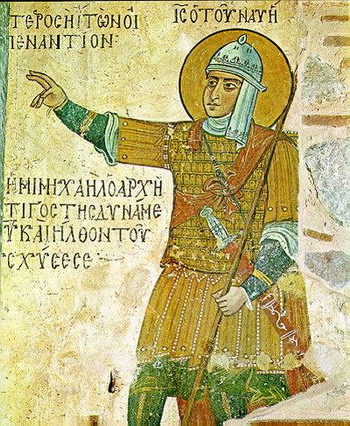
Joshua the warrior.
| 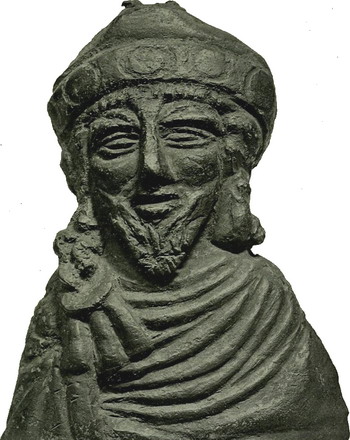
King Saul, aka Khagane Yurgan Teles,
he is the Emperor of Phocas.
| 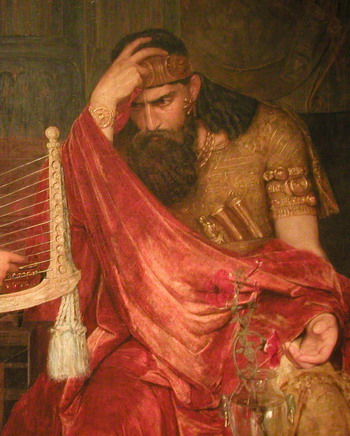
King Saul.
| 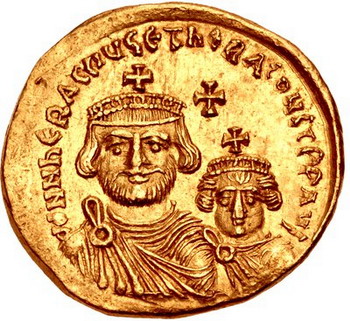
King David, he's the Khagane Kubrat, aka
the young Emperor Heraclius.
| 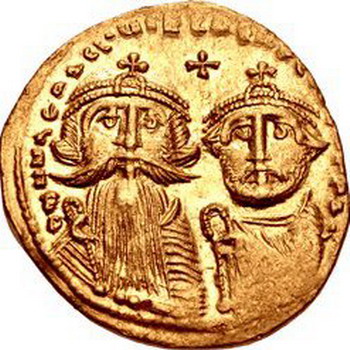
King David, he's the Khagane Kubrat, aka
adult Emperor Heraclius.
| 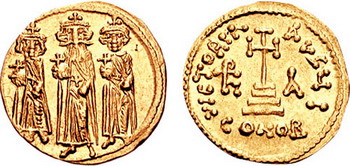
King David, he's the Khagane Kubrat, aka
old Emperor Heraclius.
| 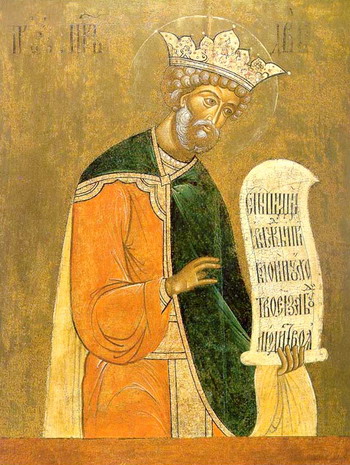
King David.
| 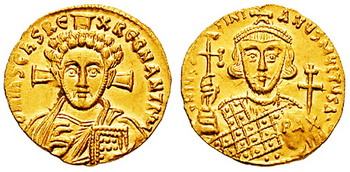
Coin: King Solomon, aka Khagane Sulabi,
aka Emperor Justinianus II Rhinotmetus (right)
| 
Coin: the face of Jesus Christ in the VII century. Christ
not yet born, no one knows his appearance.
| 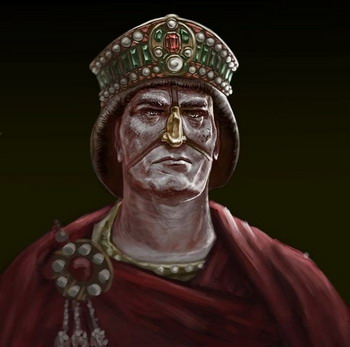
King Solomon, aka Khagane Sulabi, aka
Emperor Justinianus II Rhinotmetus (Noseless).
| 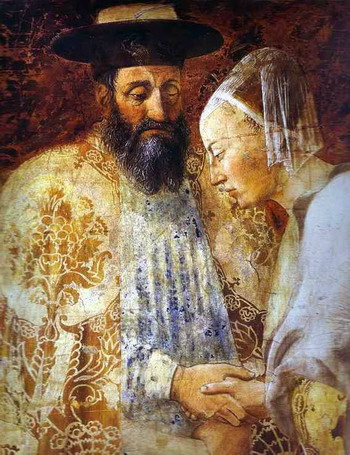
King Solomon and the Queen of Sheba.
|
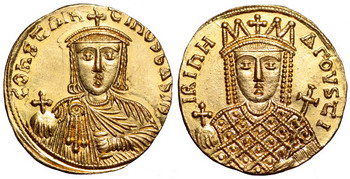
Emperor Constantine the Blind, grandfather of Rurik and Oleg the Prophetic.
| 
Emperors Constantine the Blind with his mother Irene
(she blinded her son for iconoclasm).
| 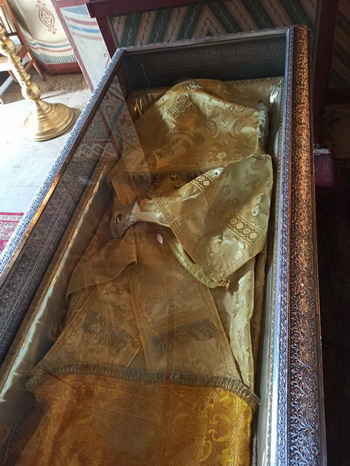
Relics of Bishop Joachim in St. Sophia Cathedral,
spiritual father of the Virgin Mary.
| 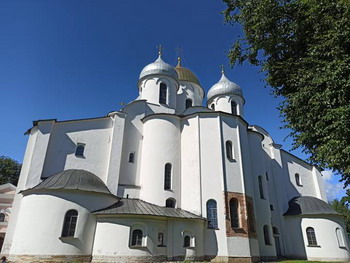
St. Sophia Cathedral, Great Novgorod. Nearby was the Church of Joachim and Anna, built by Bishop Joachim. Now the limit of Joachim is moved to St. Sophia Cathedral.
| 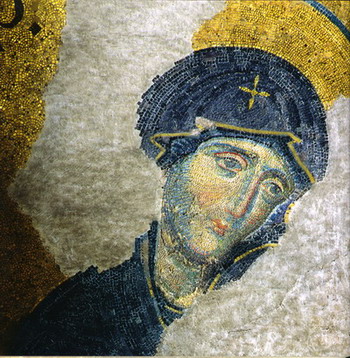
Virgin Mary (mosaic of the XI century, St. Sophia Church, lifetime portrait), her father Vladimir, spiritual father Joachim, mother Empress Anna of Byzantium.
| 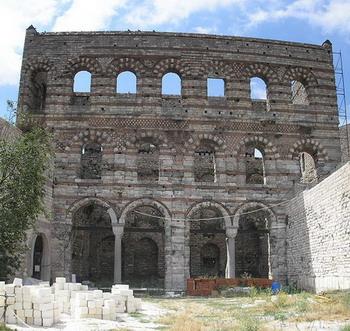
Palace of the Empress Anna and then the Virgin Mary in Blachernae, Constantinople.
| 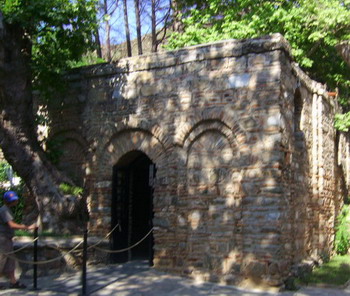
House of the Virgin Mary in Ephesus.
| 
House of Virgin Mary in Loreto, Dalmatia.
| 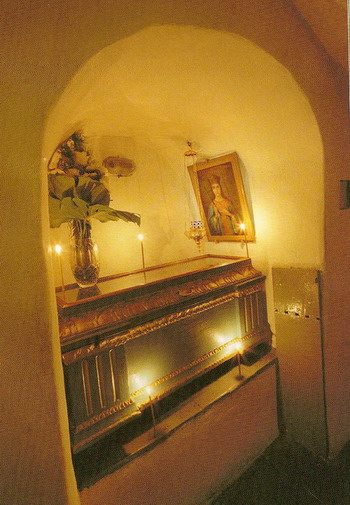
Relics of the Virgin Mary in the Kiev Pechersk Lavra, the name on the sarcophagus is Saint Juliania.
| 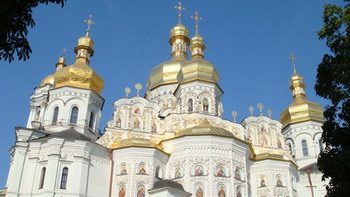
Cathedral of the Assumption of the Virgin in Kiev-Pechersk Lavra.
| 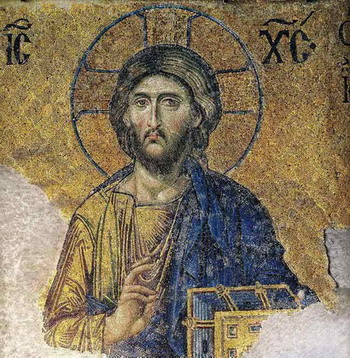
Jesus Christ Zlatoust (Chrysostom), mosaic of XI century (Hagia Sophia), lifetime portrait.
| 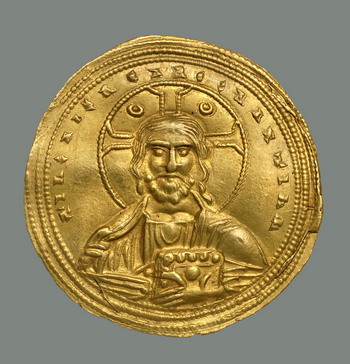
Byzantine coin with Jesus Christ, the first canonical face of the Savior on coins, beginning of the XI century.
| 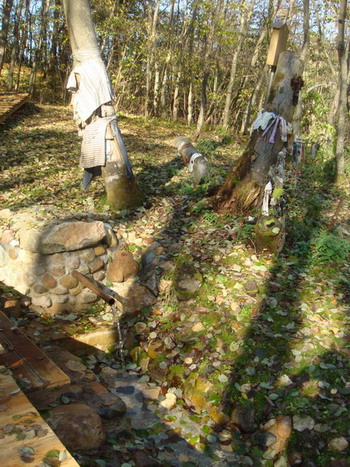
Holy Spring Golden Cup, the place of the immaculate conception of Jesus Christ, near the Roman fortress. It is 110 km from Moscow.
| 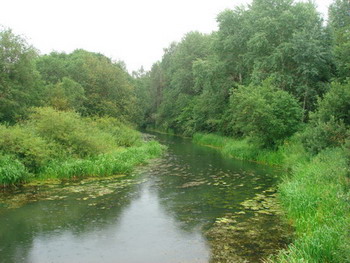
Kubra river, it flows into the water of the Holy Spring Golden Cup, the place of the immaculate conception of Jesus Christ, near the Roman fortress. It is 110 km from Moscow.
| 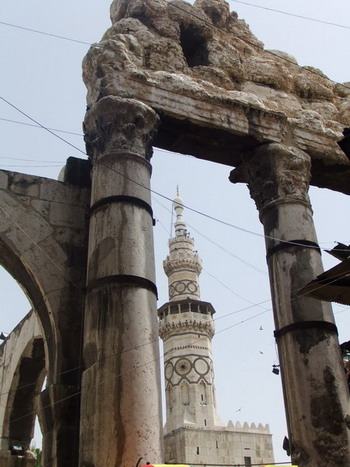
Tower of Jesus Christ, Umayyad Mosque, Damascus.
| 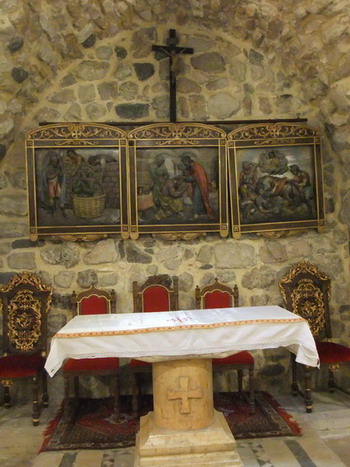
House of Saint Ananias, Damascus.
| 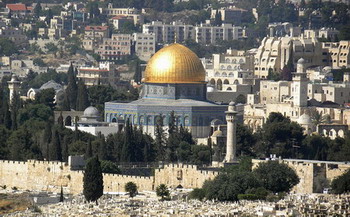
Temple of Solomon, aka Qubbat as-Sakhra, Jerusalem - El Quds. Jesus Christ was there.
| 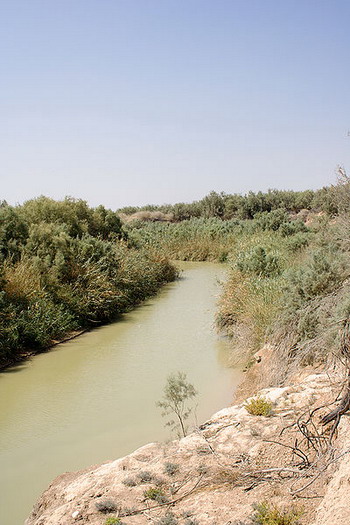
Jordan is the place of the baptism of Jesus Christ by John the Baptist.
| 
Mount Athos, the site of the Sermon on the Mount. Many Christian monasteries will soon be established there.
| 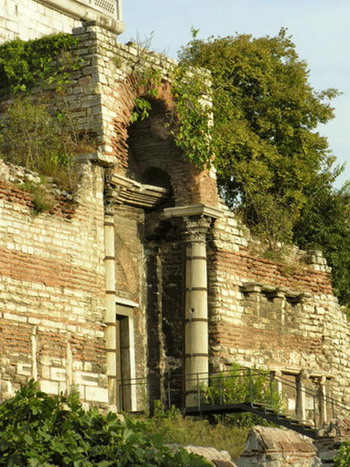
The Golden gate of Constantinople, through which Jesus Christ entered.
| 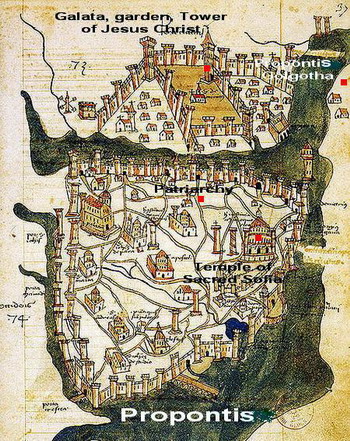
Map of ancient Constantinople with Holy places.
| 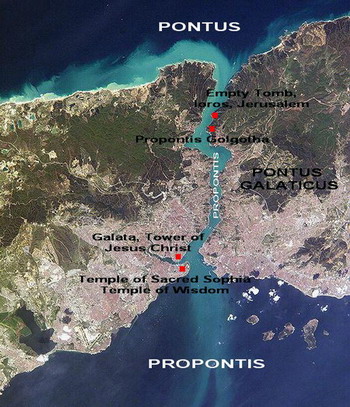
View from space of the Holy places of Constantinople.
| 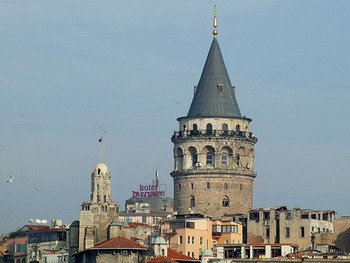
The Tower of Jesus Christ in Galata, the place of last prayer.
| 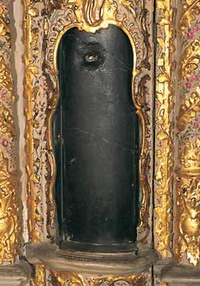
Column of the flagellation of Jesus Christ, Patriarchate of Constantinople.
| 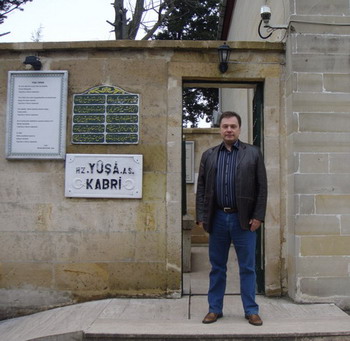
The tomb of St. Yusa (Jesus Christ) on the Mountain Beykoz, Galata, aka the Mountain Adam's Head or Box of Hercules.
| 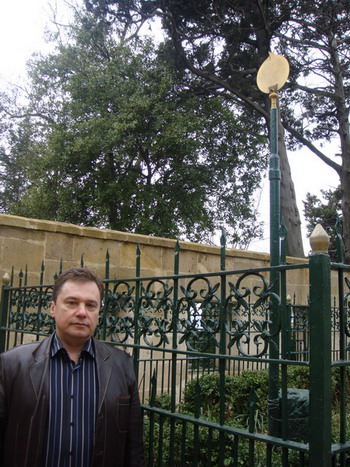
The place of the crucifixion of Jesus Christ and the Spear of Fate on Mount Beykoz, Galata, also known as Mount Adam's Head or the Bed of Hercules.
| 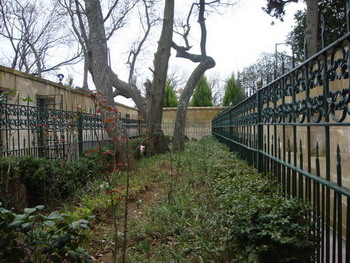
The place of the crucifixion and removal from the cross of Jesus Christ on Mount Beykoz, Galata, also known as Mount Adam's Head or the Bed of Hercules.
| 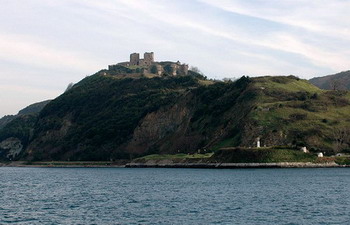
Place of the Empty Tomb in the fortress of Yoros (Jerusalem) 3 km from Mount Beykoz, Galata, also known as Mount Adam's Head or Bed of Hercules.
| 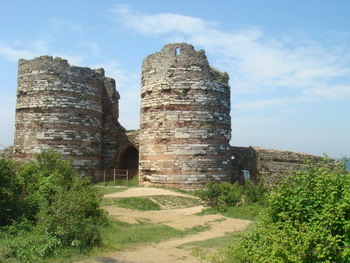
The site of the Empty Tomb in the fortress of Yoros (Jerusalem) and the ruins of the Nika Temple (Victory) of Jesus Christ, Galata, Constantinople.
| 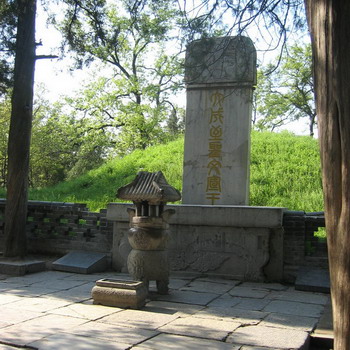
Burial place of Jesus Christ named Confucius 1054 in Qufu, Shandong province, China.
| 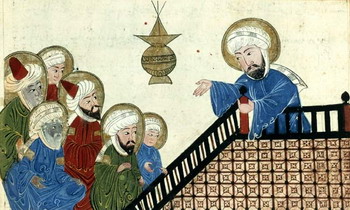
Image of the meeting of the Prophet Muhammad with followers, all with Christian halos over their heads, XII century.
| 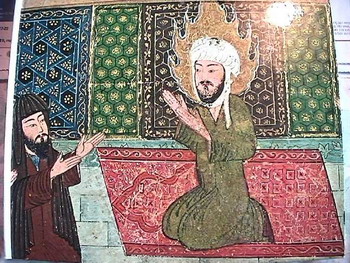
Image of the Prophet Muhammad with a fiery halo over his head, XII century.
|
|
